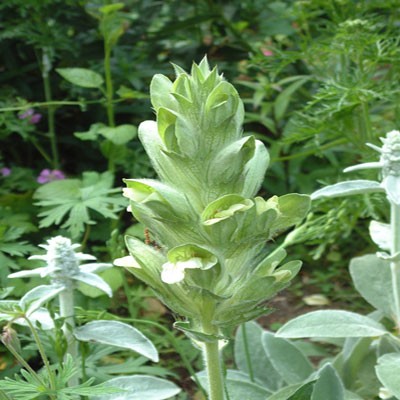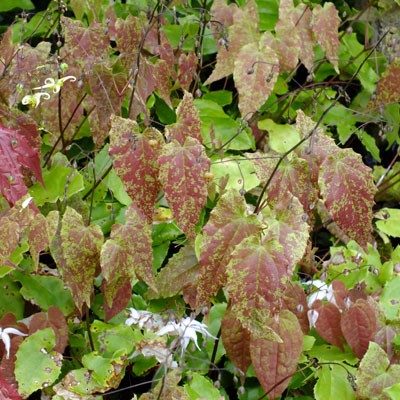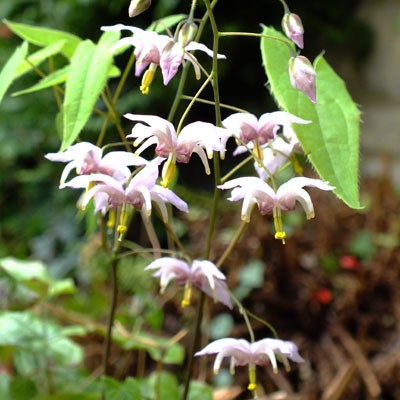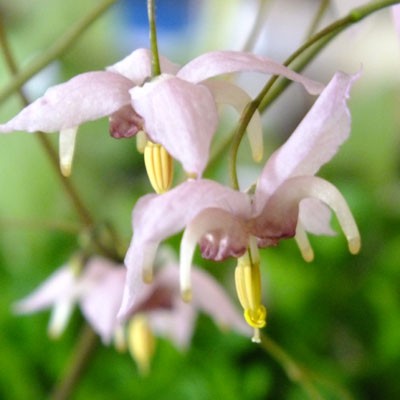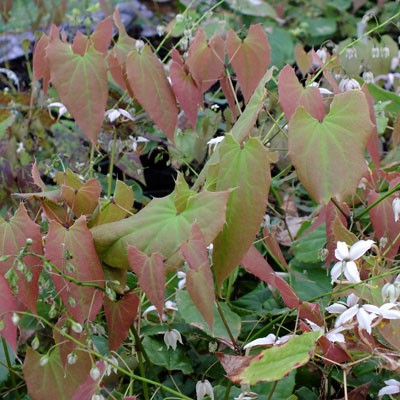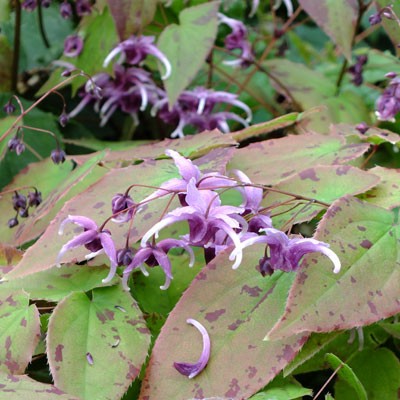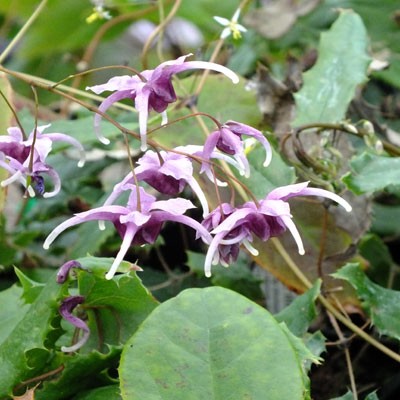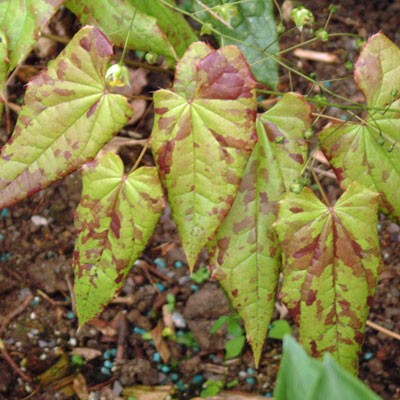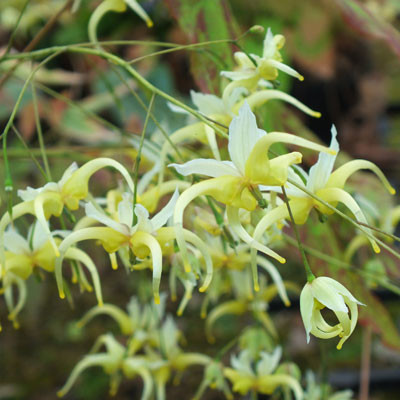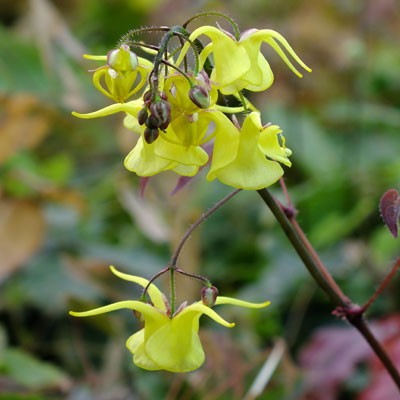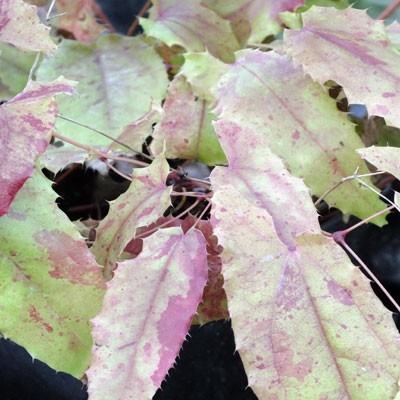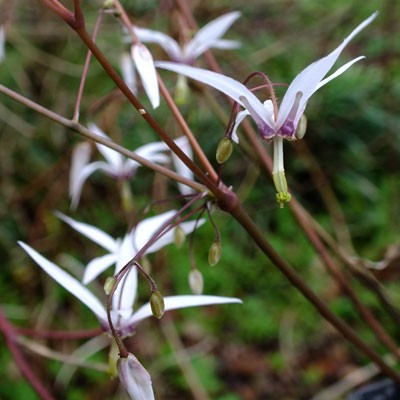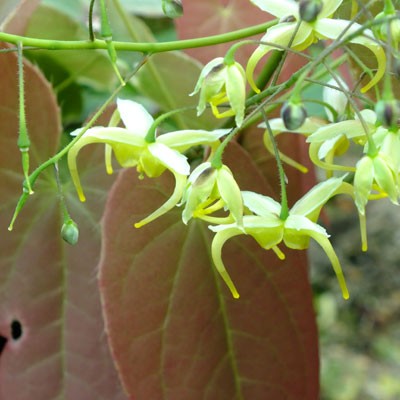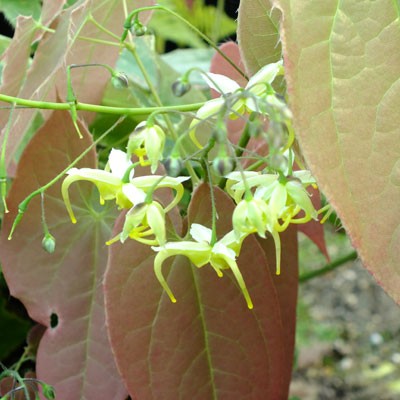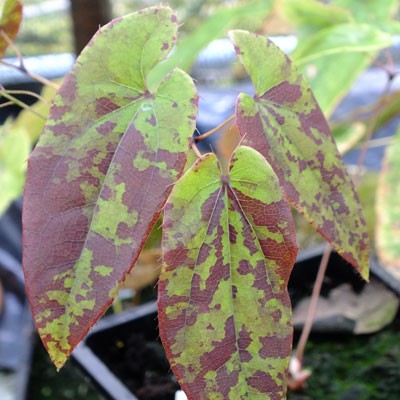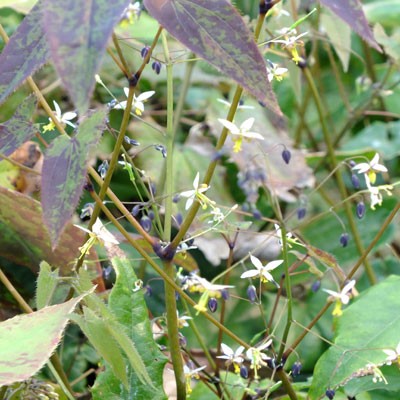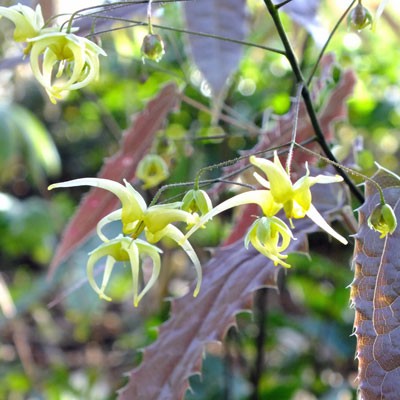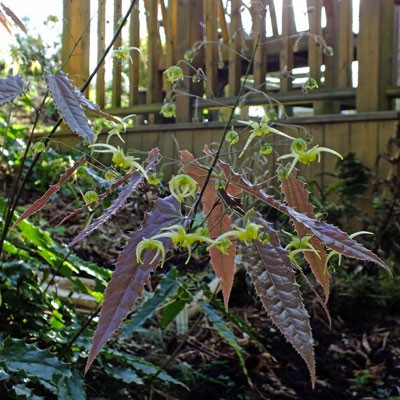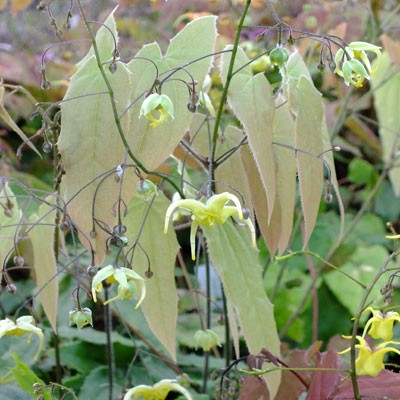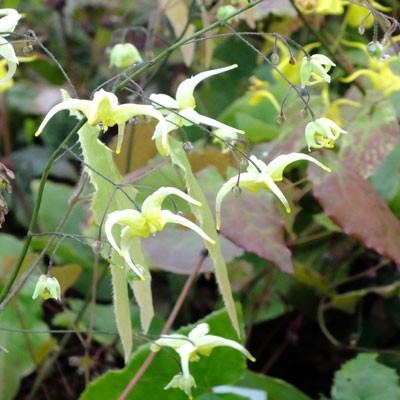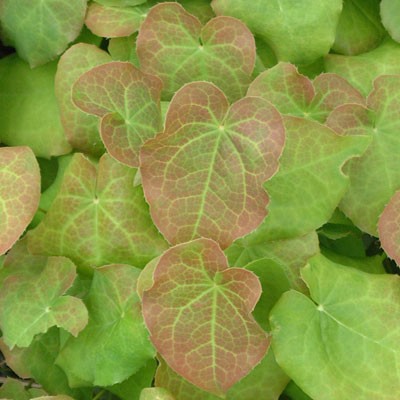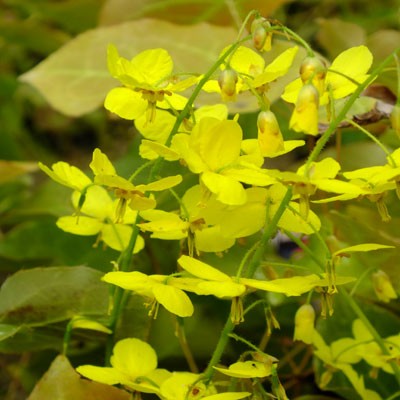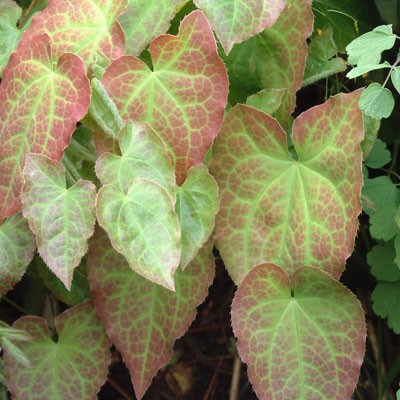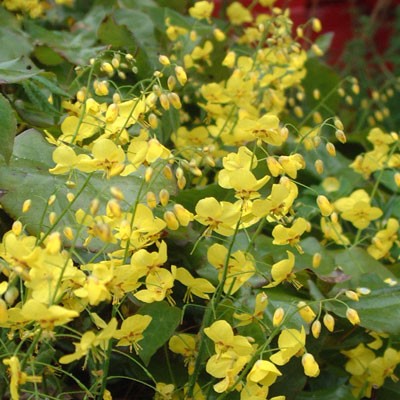-
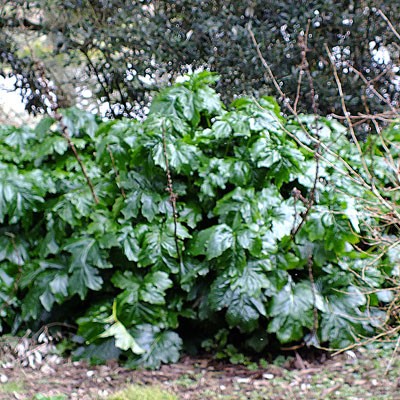
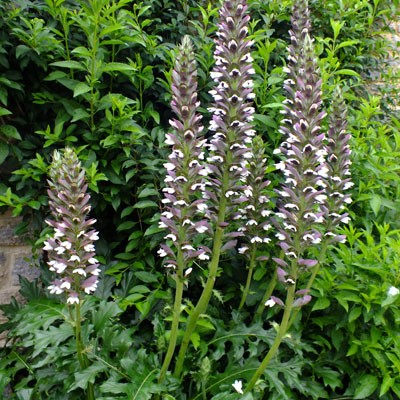
Potsize - 1L
Acanthus mollis . This is the classic Bear's Breeches that is so used in Classical decoration. Handsome deeply lobed leaves and stiff spikes densely packed with four rows of purple shrouded white flowers. This species is more open than its variety 'Latifolius' and paler in colour. Well drained soil in full sun; Height between 90 & 150cm Discount of 25p per plant for quantities of 3 or overLinks
Acanthus Compared
Botanical Style Photographs
-
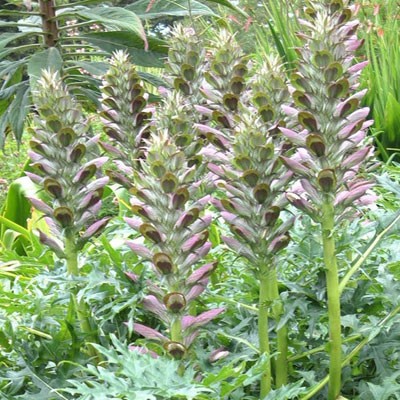
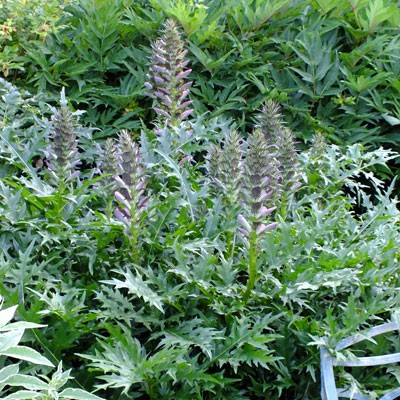
Potsize - 1L
(Acanthus caroli-alexandri) . Handsome plants with large shining ornamental foliage. This species has deeply divided glossy dark green leaves. Spires of hooded foxglove-like flowers in a two-toned purple and white. Height 4-5 feet. The foliage of Acanthus spinosus represents a midpoint between the less divided of Acanthus mollis and the extreme of spikiness, Acanthus spinosus Spinossissimus Group.Links
Acanthus Compared
Botanical Style Photographs
-
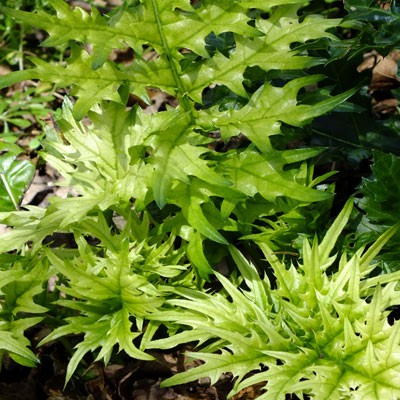
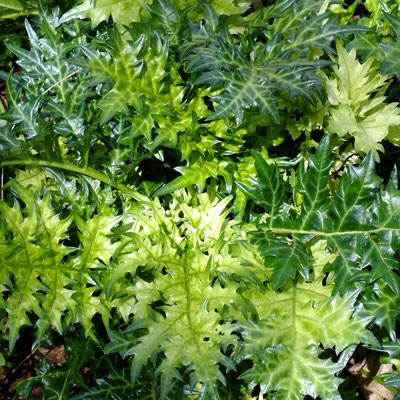
Potsize - 1L
Acanthus spinosus 'Lady Moore'. Handsome plants with large shining ornamental foliage. This species has deeply divided glossy dark green leaves, which in 'Lady Moore' are splashed and spotted cream in Spring when the plant is growing vigorously. Spires of hooded foxglove-like flowers. Height 4-5 feet. the cream variegation does not show up in potted plants.Links
Acanthus Compared
Botanical Style Photographs
-
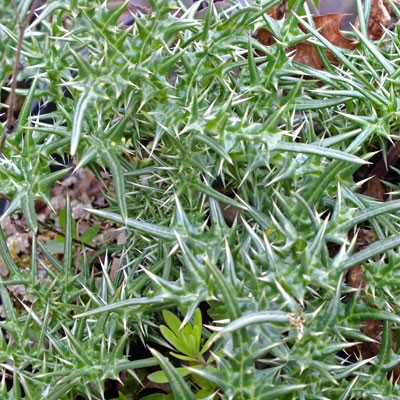
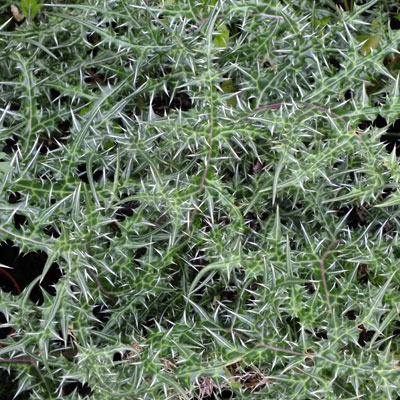
Potsize - 1L
The spiniest, prickliest form of Acanthus spinosus. The leaves are so finely cut that they are reduced to a veinal framework with every part of the leaf a handsome silver spike. It thrives in hot dry conditions although it flowers less precociously than the type. Still the foliage is amazing with its combination of dark green ground almost completely silvered over. It's ferocious mind - our neighbour grows it in his plant jail alongside his golden stinging nettle ! 75cmLinks
Acanthus Compared
Botanical Style Photographs
-

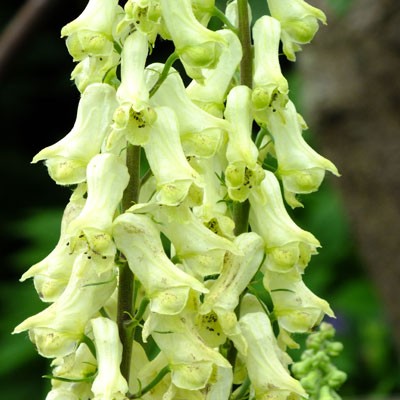
Potsize - 1L
Aconitum lycoctonum ssp. neapolitanum (lamarckii). WOLFSBANE. Tall stems with dense pyramids of narrow hooded flowers crowded higgledy-piggledy up the stem, each shaded ivory and green. Leaves are more palmate like a delphinium and less cut than other species. A real treasure for part shade. 5ft CAUTION - ALL PARTS OF THIS PLANT ARE POISONOUS Discount of 25p per plant for quantities of 3 or overLinks
Aconite Varieties Compared
Botanical Style Photographs
-
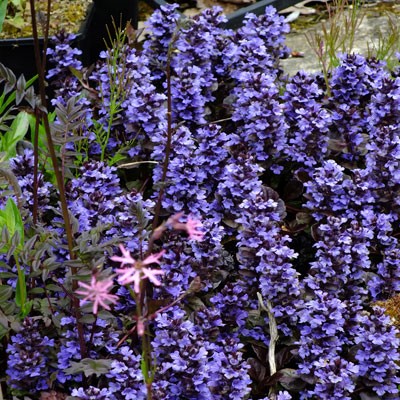
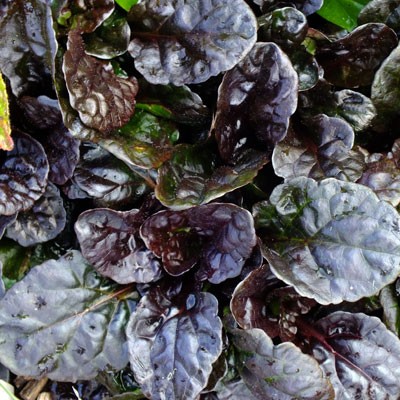
Potsize - 1L
Bugle. A good dark leaved variety with scalloped edged foliage. Lovely ground cover for a shady spot where the leaves will carpet. Flowers in short spikes above the foliage in Spring. Discount of 25p per plant for quantities of 3 or overLinks
Botanical Style Photographs
-
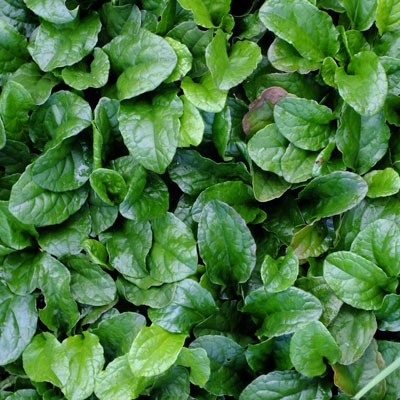

Potsize - 1L
Bugle. Lovely ground cover for a shady spot where the green leaves will make a dense carpet above which will stand dense, short spikes of pink flowers in the spring. Discount of 25p per plant for quantities of 3 or overLinks
Botanical Style Photographs
-
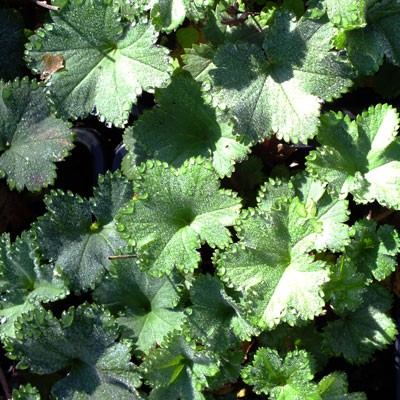


RHS AGM
Potsize - 1L
A smaller form of the otherwise similar Alchemilla mollis with beautiful scalloped, serrated edged foliage which often takes on a blueish-grey hue. Typical chartreuse sprays of flowers are produced in Summer on purply stems and act as a lovely foil to other blooms. Grows about 6 inches high and 8 inches wide and, apart from needing sun for at least part of the day, is very undemanding.Links
Alchemilla in the Garden
-

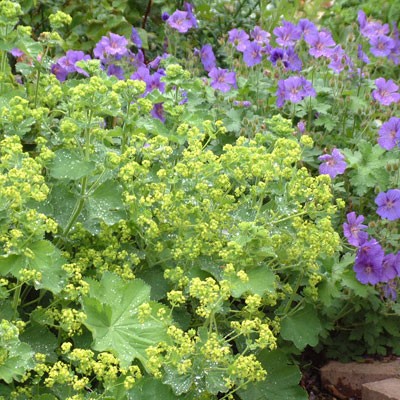
Potsize - 1L
Alchemilla mollis. Scalloped hairy leaves form a dense clump and are a delight when bejewelled with dew or raindrops. The flower heads are like a dense limey green gypsophila. A fantastic tough and rewarding plant that will grow happily in all but soggy sites, thriving in dry shade. It assorts remarkably well with so many other plants as well. The colour of the flowers of Alchemilla is derived from two rows of sepals, the flowers lack petals. Medieval alchemists believed the water droplets that collected in the centre of alchemilla leaves possessed magical and medicinal properties. The plant has a long tradition of being used to cure women's ailments and the plant was consequently named in dedication to the Virgin Mary. The leaves were seen as resembling a mantle (cloak). Alchemilla derives from the Arabic word 'alkimiya' = alchemy Discount of 25p per plant for quantities of 3 or overLinks
Alchemilla in the Garden
-
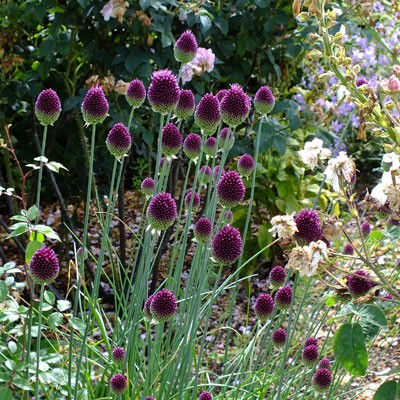
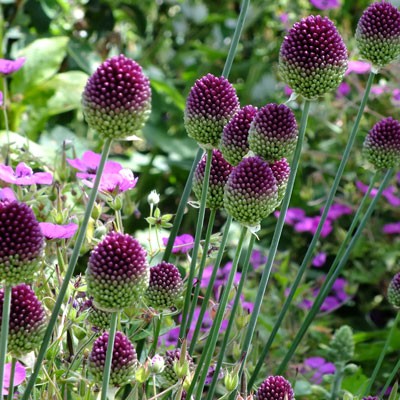
Potsize - 9cm
Allium sphaerocephalon. Pear-shaped heads, densely packed with flowers begin green and gradually turn a deep pinky-purple, the colour spreading from the top until the whole head is coloured. All the time the heads maintain their dense drumstick form, swaying on impossibly thin stems. Try naturalising in grass or in a prairie style planting. July. 60cm. From fields and dry verges from Britain, across Europe and North Africa to Israel.Discount of 25p per plant for quantities of 3 or over -

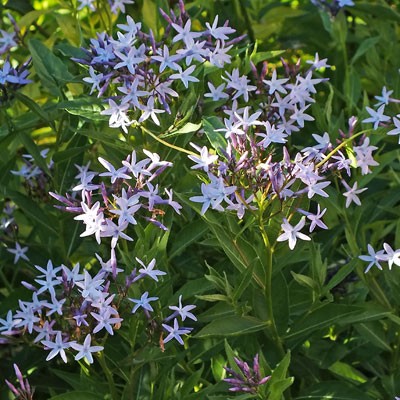
Potsize - 1L
This is a compact form growing just 35-40cm high with the deepest lavender-blue flowers of any Amsonia. It arose in a seedling batch of Amsonia tabernaemontana on a nursery in Connecticut and is thought to possibly be a hybrid with Amsonnia hubrechtii. It pays its way all year with neat shiny green leaves on a compact easy care plant, topped with flowers in June to July which emerge from long dark buds. It takes on lovely yellow Autumn colours in Autumn. Perfect as an edging plant. It does start off slowly but builds up stature year on year, rarely needing dividing. Good for butterflies and Deer resistant. -
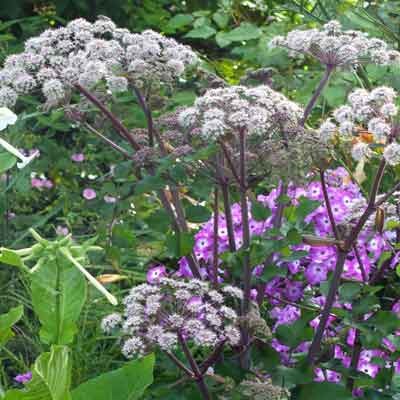
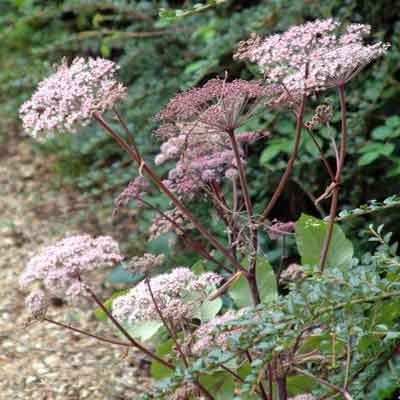

Bee Friendly
Potsize - 1L
Angelica sylvestris 'Purpurea' . Starting remarkably early in the year this plant pushes up fascinating glossy purple foliage, soon becoming an imposing architectural feature topped with a dense spherical head of pink flowers. In appearance not dissimilar to a more sturdy cow parsley, but with less air and more presence. Will seed about mildly. Likes a good moist spot. Discount of 25p per plant for quantities of 3 or overLinks
Umbellifers
-
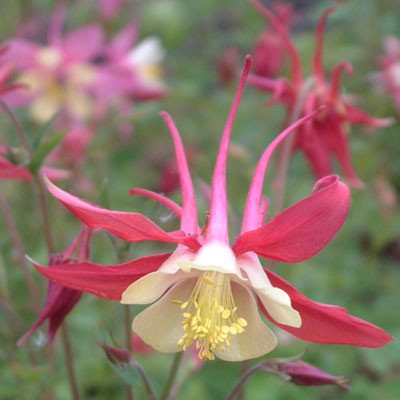
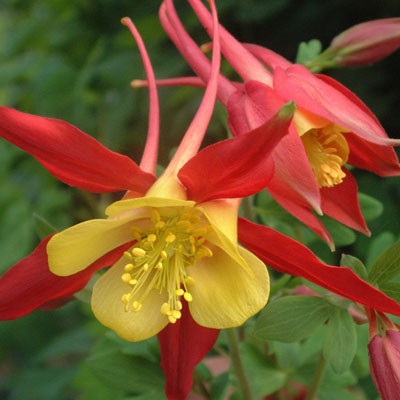
Potsize - 9cm
Aquilegia 'Koralle' An old cottage garden favourite and a good cut flower. Abundant display in late spring of long spurred red and yellow flowers over fine blue-green foliage. 80cm. Full sun. Medium height variety. A seed grown strain that might display some variation in colour and form. HARMFUL IF EATENDiscount of 25p per plant for quantities of 3 or more of this variety, 50p for 10 of any AquilegiaLinks
Aquilegia Compared
-


Potsize - 9cm
Aquilegia 'Yellow Star' (Star Series). An old cottage garden favourite and an excellent cut flower. Abundant display in late spring of long spurred two-toned lemon yellow flowers over fine blue-green foliage. Do not overcrowd the crown or allow other plants to flop over the foliage. 60cm. Full sun. HARMFUL IF EATENDiscount of 25p per plant for quantities of 3 or more of this variety, 50p for 10 of any AquilegiaLinks
Aquilegia Compared
-
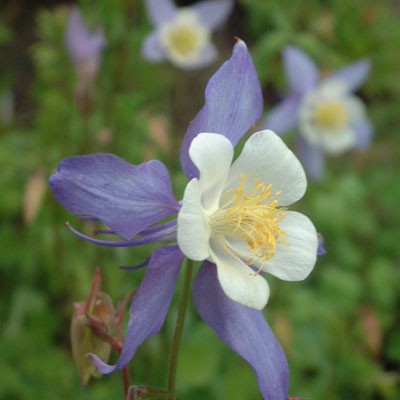

Potsize - 9cm
Aquilega 'Heavenly Blue' ('Sky Blue', 'Blue Dream'). A long spurred aquilega whose flowers are a rich cobalt blue with contrasting white corolla. A cottage garden favourite & an excellent and unusual cut flower. May to June. 85cm. A Medium height variety. allow some air around the crown. HARMFUL IF EATENDiscount of 25p per plant for quantities of 3 or more of this variety, 50p for 10 of any AquilegiaLinks
Aquilegia Compared
-
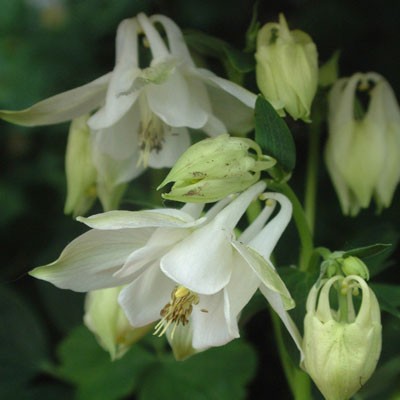
Potsize - 9cm
Large pure-white, gracefully nodding bonnets, each 4cm wide are borne on leafy stems 80cm high in great profusion. Often tipped with green on ageing, the spurs are short and slightly curled. The attractive divided foliage forms a basal clump of fresh apple-green, leafing up early in Spring to make a lovely foil for bulbs and early Primroses in the garden. They start pushing up flowering stems as early as April and go on producing a sequence of blooms until early June. They are deep rooted plants which seek water well and are therefore tolerant of dry shady conditions as well as full sun. The pure white blooms really lighten up a shady spot and look wonderful with cool greens and ferns. Although 'Munstead White' grows true from seed collected from isolated plants, Aquilegias are highly promiscuous members of the Ranunculaceae and will take any opportunity to mix their genes with their kin producing seedlings of a wide range of colours and spur lengths.Discount of 25p per plant for quantities of 3 or more of this variety, 50p for 10 of any AquilegiaLinks
Aquilegia Compared
-

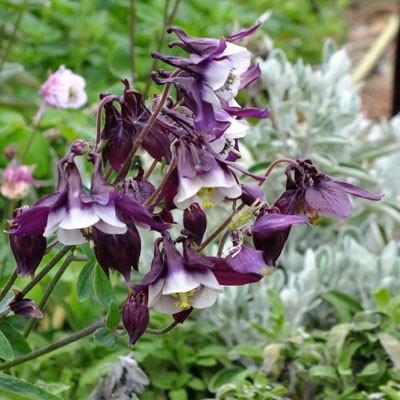
Potsize - 9cm
Aquilegia vulgaris 'William Guiness' ('Magpie') A recent introduction with striking flowers in bicolour white and deep purple (near black). The flowers are of traditional nodding A. vulgaris form with well flared petals and curve-tipped spurs. Would look good in a mixed cottagey border Best in light shade. 90cm HARMFUL IF EATENDiscount of 25p per plant for quantities of 3 or more of this variety, 50p for 10 of any AquilegiaLinks
Aquilegia Compared
-
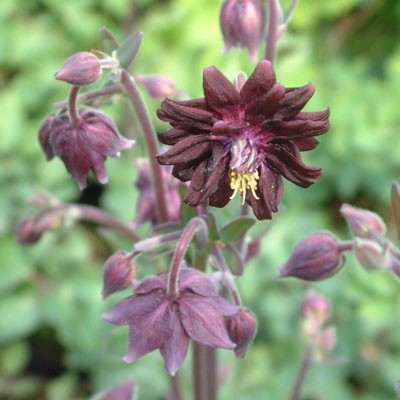
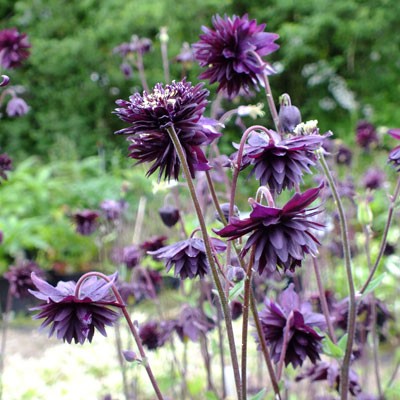
Potsize - 9cm
Aquilegia vulgaris var. stellata 'Black Barlow' (Barlow Series). One of the spur-less Barlow series based around the plant originally found in the garden of Nora Barlow. This form has flowers that are a deep dusky maroon. Would look good in a mixed cottagey border, hanging above paler mounds of flowers. Best in light shade. HARMFUL IF EATENDiscount of 25p per plant for quantities of 3 or more of this variety, 50p for 10 of any AquilegiaLinks
Aquilegia Compared
-

Potsize - 9cm
A fitting name for this richly claret coloured, very double. Spurless Aquilegia. A tall elegant variety with strong stems. 60-90cmDiscount of 25p per plant for quantities of 3 or more of this variety, 50p for 10 of any AquilegiaLinks
Aquilegia Compared
-
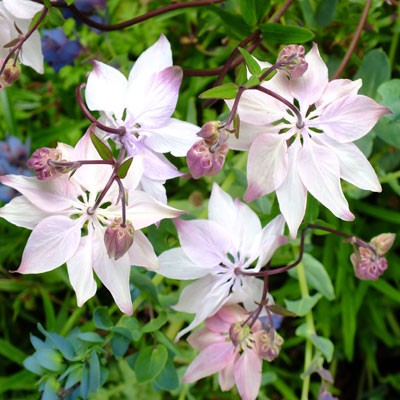

Potsize - 9cm
Aquilegia vulgaris var. stellata ( A. clematidiflora ). A variation on an old cottage garden classic. This is the root of all of those double flowered forms that you find under the 'Barlow' banner. It is a lovely thing, having quite flat flowers, lacking the usual Aquilegia spurs, and having more than a passing resemblance to a clematis. The stems are tall and all the pale fleshy-pink flowers look down so that you look on the backs of the flowers. easy and well worth squeezing into a mixed bed. Will freely seed about in any well drained soil and cheer any planting in late spring with its wonderful array of pastel flesh pink blooms. Any soil that is not too wet. full sun. 60cmDiscount of 25p per plant for quantities of 3 or more of this variety, 50p for 10 of any AquilegiaLinks
Aquilegia Compared
-
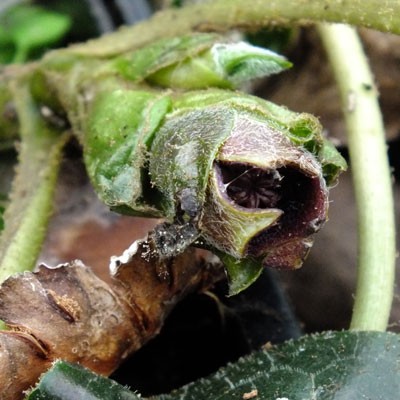
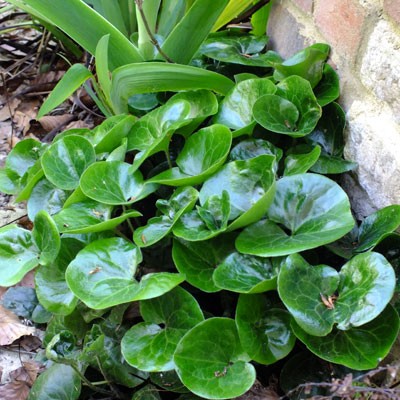
Potsize - 1L
Asarum europaeum - Asarabacca. Shining evergreen foliage interest for moist shade where creeping rooting stems form loose ground cover. Curious fly pollinated flowers appear in spring. Asarum europaeum - Asarabacca - may not be the most showy but everything about it cries out class. The leaves are a lovely glossy deep green and evenly rounded, the perfect counterpart to filigree plants like Maidenhair ferns. It will grow in dry shaded locations where it will make good groundcover and if you care to lower your nose to it you'll catch a rich spicy aroma. It is certainly one of my favourites. CAUTION. All parts of this plant are poisonous. -
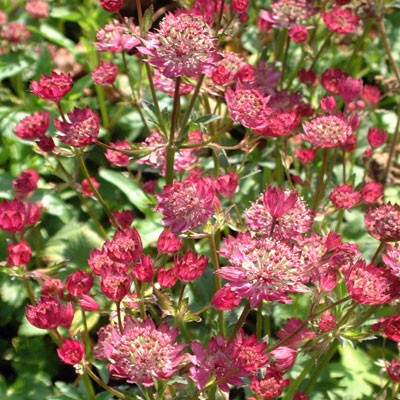
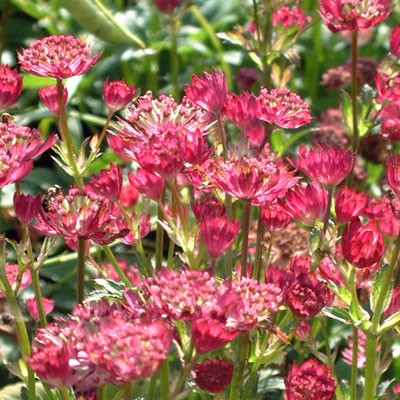
Potsize - 1L
A recently selected large flowered dark red masterwort. Tight clusters of maroon flowers are surrounded by beautiful ray florets. An interesting & beautiful plant happy in sun or part shade with some drainageLinks
Astrantia Compared
Astrantia in the Garden
Botanical Style Photographs
-
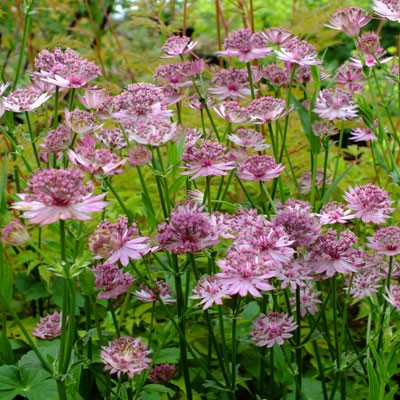
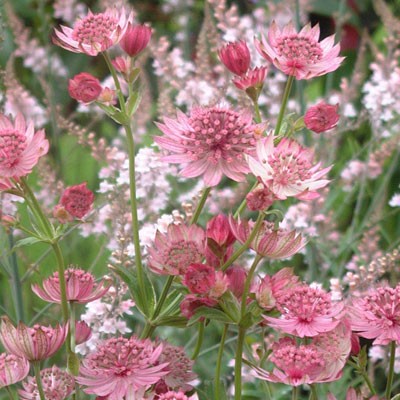
Potsize - 1L
Astrantia 'Roma'. Lovely mid pink cultivar of good constitution. The bracts form a shallow starry cup that is a shade lighter than the tight central pincushion of true flowers. 60cm. An interesting & beautiful plant Happy in sun or part shade with some drainageLinks
Astrantia Compared
Astrantia in the Garden
Botanical Style Photographs
-
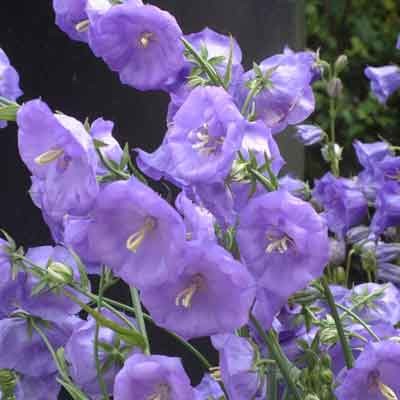
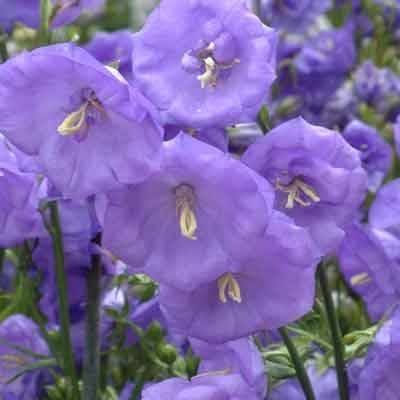
Potsize - 1L
Campanula persicifolia 'Blue Bloomers'. A blooming good variety with large flowers that are more saucer shaped than the type. They are a good strong blue and have a extra set of petals creating a hose in hose bloom. One of the taller varieties. Evergreen foliage. Good on chalky soilsDiscount of 25p per plant for quantities of 3 or overLinks
Campanula Compared
Botanical Style Photographs
-
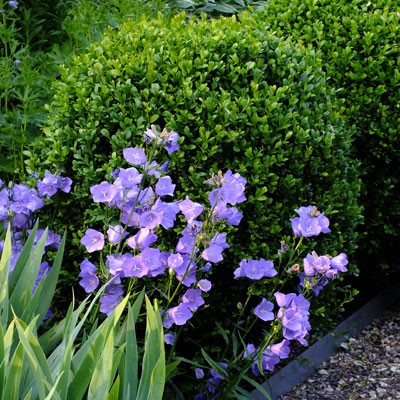
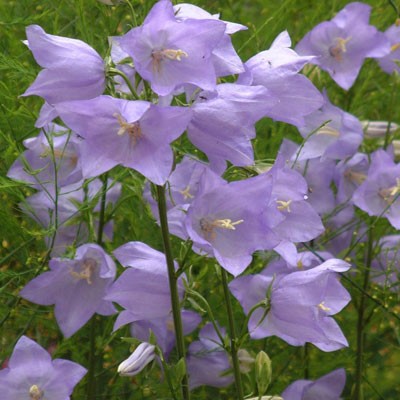
Potsize - 1L
Campanula persicifolia 'Grandiflora'. Like a large version of a harebell Dense clumps of foliage and a succession of sky blue bells. Height 80cm Excellent cut flower. Good on chalkDiscount of 25p per plant for quantities of 3 or overLinks
Campanula Compared
Botanical Style Photographs
-
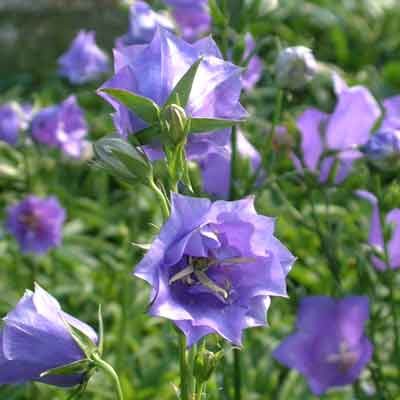

- Bee Friendly
- RHS AGM
Potsize - 1L
The flowers of this beautiful variety are well cupped with a second inner cup that is ruched, giving a quite double impression. The colour is a strong violet blue which, coupled with a relatively dense habit and closely spaced flowers, makes for a most striking variety. Height 80cm Excellent cut flower. Good on chalk. Possibly the shortest of the C.persicifolia varieties and one of several different plants introduced with the name 'Pride of Exmouth' by the Exmouth based Horticulturalist and Seedsman WJ Godfrey FRHS FNCS (1858-1927). One of his last introductions, coming to the trade not long before the end of his life.Discount of 25p per plant for quantities of 3 or overLinks
Campanula Compared
Botanical Style Photographs
-
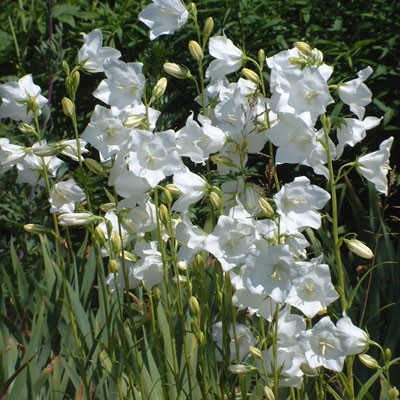
Potsize - 1L
Campanula persicifolia 'Alba'. The large bells of this variety are a pure glistening white. A real elegant flower that associates well with greens and blues, lifting any scheme it is planted in. Height 80cm Excellent cut flower. Good on chalk. Can be grown in shade.Discount of 25p per plant for quantities of 3 or overLinks
Campanula Compared
Botanical Style Photographs
-
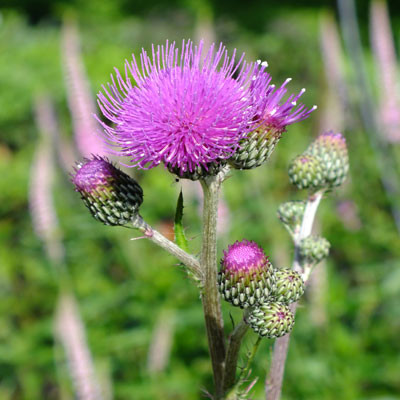

- Butterfly Friendly
- Bee Friendly
Potsize - 1L
Queen Anne Thistle. This is a native thistle from Europe, being found right across into Russia. It's no shrinking violet, but unlike some of the other members of the Cirsium genus it tends to stay put in one place and not become 'weedy'. It grows a generous basal rosette of largely non-spring leaves and throws up tall branching flower spikes up to 2m plus topped with generous thistle-knobs at the top. If you have the space its a great statement plant and great too for the wildlife, providing nectar for insects, seeds for the finches and a food plant for Painted Ladies. For a moist soil.Discount of 25p per plant for quantities of 3 or overLinks
Botanical Style Photographs
-
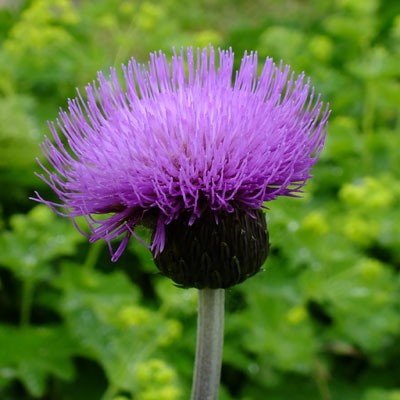
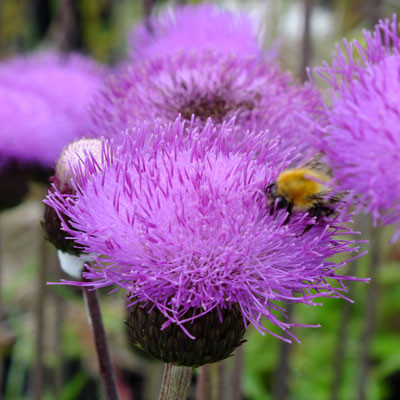
- Butterfly Friendly
- Bee Friendly
Potsize - 1L
Melancholy Thistle. Broader leaves, a more spreading habit and larger flowers than its cousin Cirsium rivulare. Later in the year to flower as well. The reason for the name heterophyllum comes from the variability of the leaf form, which becomes more divided on the flowering stalks than the basal rosettes. In shade this plant will grow well but flower poorly. Give it plenty of moisture and sun to see it at its best. The plant was considered a possible cure for sadness. Nicholas Culpepper in 1669 said that it "makes a man as merry as a cricket" Discount of 25p per plant for quantities of 3 or overLinks
Botanical Style Photographs
-
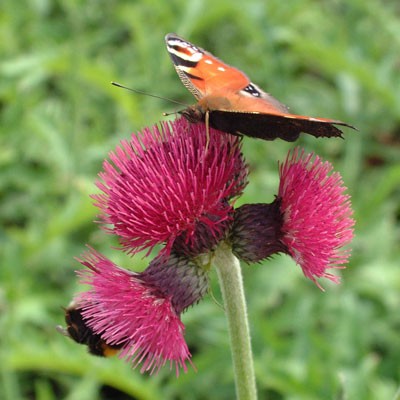
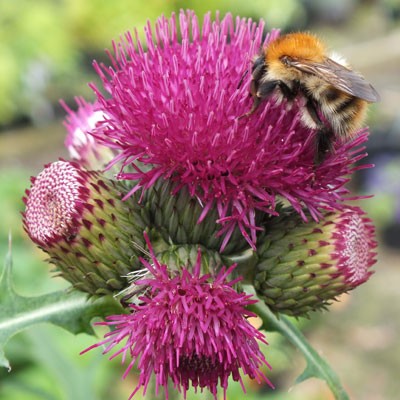
- Butterfly Friendly
- Bee Friendly
Potsize - 1L
Cirsium rivulare 'Atropurpureum'. Attractive thistle with stout erect flowering stems generously topped with rich red-purple thistle knobs. Easy and rewarding plant with strong architectural character. Grows best with moisture. 1m. June and then sporadically afterwards. A Magnet for bees and butterflies Discount of 25p per plant for quantities of 3 or overLinks
Botanical Style Photographs
-
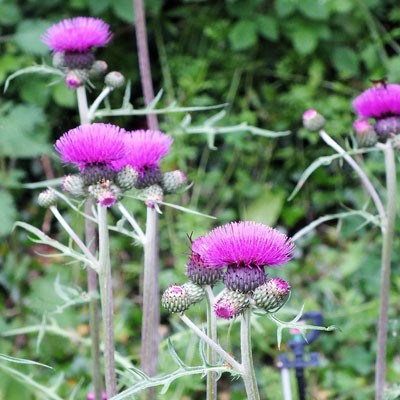

- Butterfly Friendly
- Bee Friendly
Potsize - 1L
Cirsium rivulare 'Trevor's Blue Wonder'. A new variety that compliments its similar cousin C.rivulare 'Atropurpureum'. Whilst being superficially similar it has flowers that are bluer in hue and are carried on stems that are purple stained over white pubescence. A little stiffer and more vigorous in growth. Like all Thistles, the flowers are a magnet for butterflies. 1m, May-June and then sporadically through the season. Would like a moist site. Discount of 25p per plant for quantities of 3 or overLinks
Botanical Style Photographs
-

Potsize - 9cm
Convallaria majalis. Lily-of-the-Valley. One of those perennials that really needs no introduction. It is native to Britain and is particularly common on Lime rich soils, growing thick tangled mats of root in woodland situations. Each node produces two broad leaves in the middle of which nestle the stiff little spikes hung on One side with little fragrant white bells, Each with a narrowed frilly opening like an old-fashioned maids bonnet. Lily-of-the-Valley is easily grown and adaptable and particularly suited to leaving alone in difficult dry situations where It will happily carpet and provide fragrant little posies Each SpringDiscount of 25p per plant for quantities of 3 or overLinks
Lily-of-the-Valley - Botanical Style Photographs
-
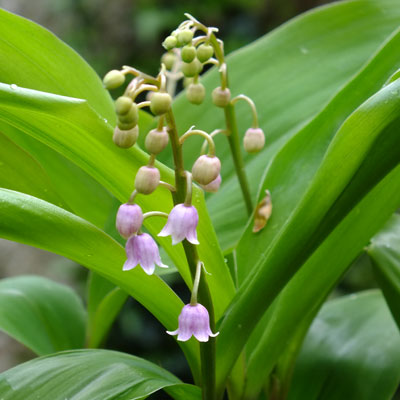

Potsize - 1L
This is the pink flowered form of Lily of the Valley. I recently read it described as 'a stunning new variety' but I'm going to resist such hyperbole. It is pleasant and different with a subtle, if a liitle dull, pink shading on the outside of each bell. The leaves are a little bluer in shade as well. Its a great addition to a collection and I don't want to denegrate its charms, just don't ecpect to have your socks blown off and you'll be well pleased.Discount of 25p per plant for quantities of 3 or overLinks
Lily-of-the-Valley - Botanical Style Photographs
-
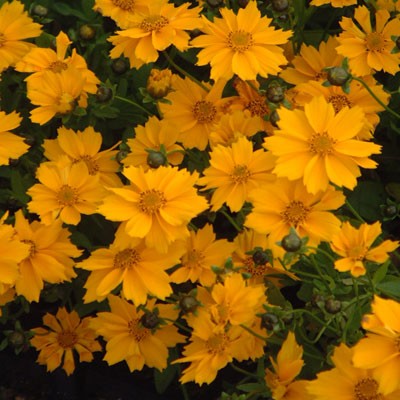

Potsize - 1L
Coreopsis auriculata 'Zamphir' is a bright ray of sunshine for early summer. A spreading clump former for the front of the border which will delight with a dense covering of 5cm rich yellow daisy flowers. 30cm. Keep dead-heading to keep the flowers coming.Discount of 25p per plant for quantities of 3 or over -

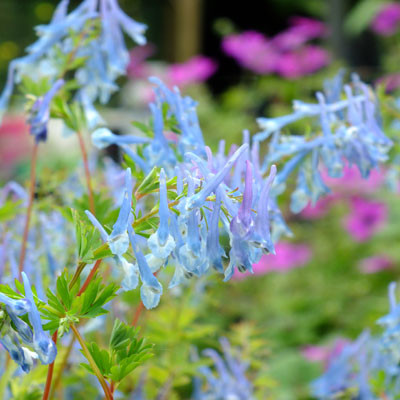
Potsize - 1L
A cross between Corydalis fleuosa and Corydalis omeniana from Ian Young's garden in Aberdeen. Vigorous clumps of limey, chartreusy-green juicy fern-like foliage over which come the strongly scented sky-blue flowers. Like Corydalis elata, but smaller and colouring only very slightly in the stems. Wintergreen and very hardy if grown in a moisture retentive soil which is not over wet and doesn't dry out in the Summer. Divide every three years to maintain vigour and encourage the best flowering. Flowers from Spring until June. 30cmLinks
Corydalis Compared
-
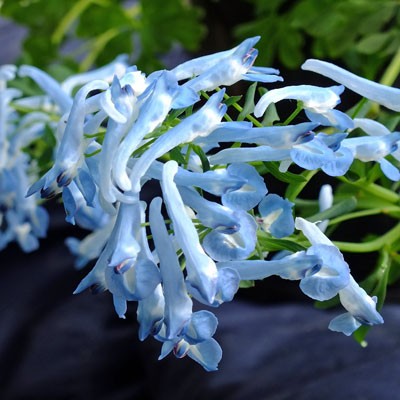

Potsize - 1L
A new repeat flowering variety with intense bright deep turquoise blue flowers that can appear from Early Summer right through until Autumn if moisture remains present. A hybrid of Corydalis flexuosa and Corydalis cashmeriana produced by Keith Lever. Short at 20-30cm. A short variety that retains the compact charm of C.cashmeriana but with a greater degree of vigour. Almost evergreen, taking on good colour in the flower stems with adequate moisture throughout the season.Links
Corydalis Compared
-
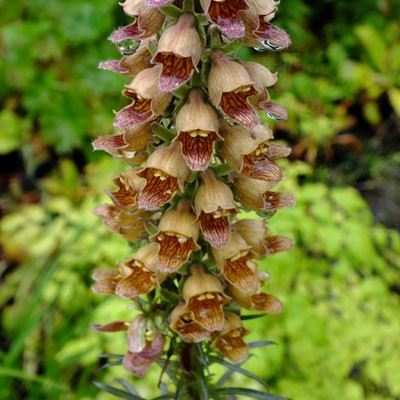
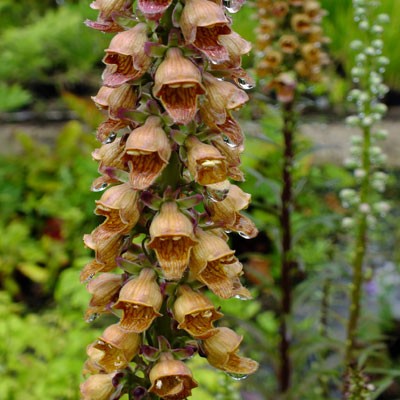
- Bee Friendly
- RHS AGM
Potsize - 1L
Digitalis ferruginea 'Gelber Herold' (Yellow Herald) . Immaculate evergreen glossy rosettes of long, narrow dark green leaves are a feature all year. The flowers spikes are tall, stiff and densely crowded with charming ochre, yellow-lipped flowers arranged all around the stem in perfect regularity. More yellow in the flowers than the species. 4ft CAUTION- TOXIC IF EATENDiscount of 25p per plant for quantities of 3 or overLinks
Foxgloves Compared
-
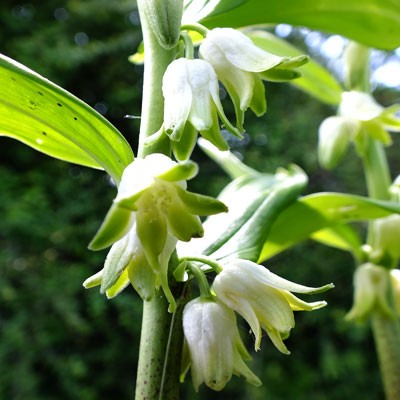

Potsize - 1L
Disporopsis pernyi - Evergreen Solomon's Seal. A relative of the solomon's seal, this spreading perennial has dark green leaves and hanging flared bells that are said to have a lemon scent, but I get more of a nutmeg vibe. A graceful plant for shade. This plant is a long time in bud before the flowers open which is really rather pretty. 60cmDiscount of 25p per plant for quantities of 3 or overLinks
Botanical Style Photographs
-
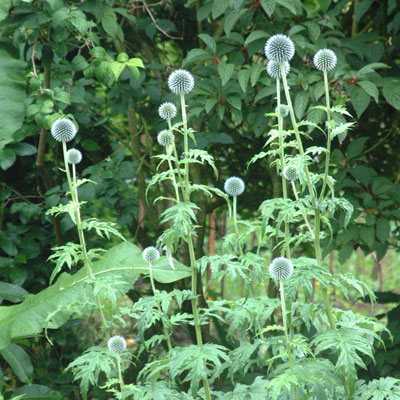
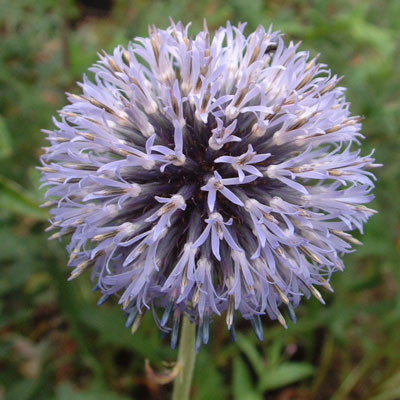
Potsize - 1L
Hungarian Globe Thistle. An intensely blue selection of this species, said to be far superior to forms of Echinops ritro. Large too, flowering at 120cm tall. Flowers from July to October. The species originates from Central to Eastern Europe through to Asia Discount of 25p per plant for quantities of 3 or over -

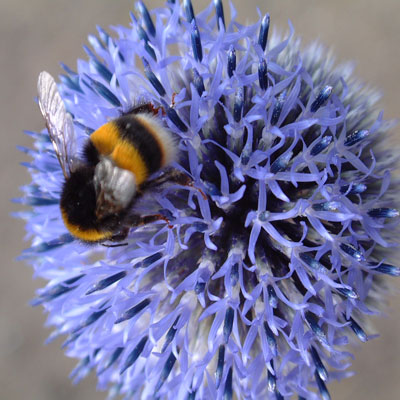
Potsize - 1L
Echinops tenuifolius. This species was singled out by William Robinson as the most magnificent in its family. The foliage is the finest, being more finely divided than other and it is a stark white on the reverse. The stems also are white woolly. Flower heads start off as spiky silver balls, becoming brilliant bright blue when the flowers are fully open. On the shorter side at 60cm and flowering from July to September. The species from Southern and Eastern Europe across to Russia and China. Discount of 25p per plant for quantities of 3 or over -
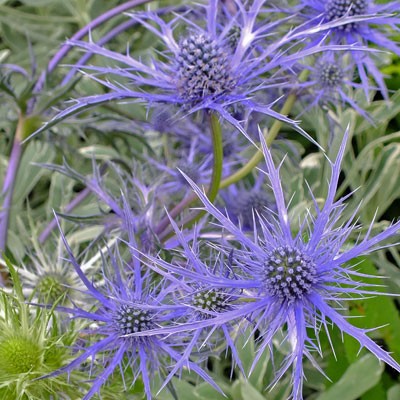

Potsize - 1L
This is really a very fine Sea Holly indeed in more than one sense of the word. Eryngium 'Pen Blue' is in the x zabelii family with sea-green tripartite leaves. The flowers are borne on 60cm violet stems and are a picture of beauty. The collar is particularly wide in comparison to the central cone and its segments, radiating like the spokes of the devil's chariot are narrow, spiky and a striking electric Blue. Further adding to the effect, the flowers are beautifully arranged and composed with the secondary flowers slightly smaller and held a little lower. Altogether a class act and a magnet for the bees. Found by Jane Edmunds in her garden in Penselwood, Somerset.Links
Eryngiums Compared
Botanical Style Photographs
-
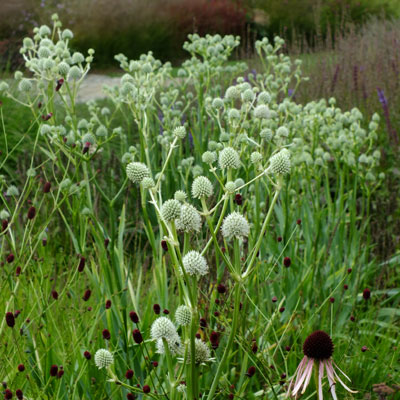

Potsize - 1L
Eryngium agavifolium. An architectural species which hails from stony hillsides and rocky riverbanks in the Cordoba region of Argentina. It has long pale green strap-like leaves with spiny edges, probably the broadest of the commonly grown long leaved species. The flower spikes are stiff 1m stalks topped with a small terminal knob of greeny white spiny cones. We've had this plant for years, but it has taken me many years to persuade Dawn of its merits. She's finally given in so it remains to be seen if I'm vindicated. A bold statement and Great for the bees. For full sun in a well drained but not dry soil. Hardy to -10 if really happy, less if miserable.Discount of 25p per plant for quantities of 3 or overLinks
Eryngiums Compared
Botanical Style Photographs
-

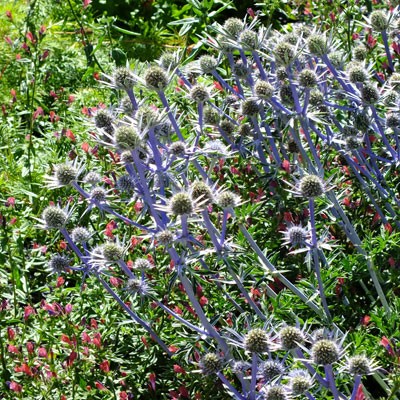
Potsize - 1L
Eryngium bourgatii . Rosettes of deeply cut crisp, curly grey-green leaves with silver veins make a notable feature all on their own. The clump gives rise to branching spikes of blue-green thistles with blue spiky bracts that begin silver. A beautiful plant all year 60cm (2ft) high which needs well drained soil in full sun. Great for the beesDiscount of 25p per plant for quantities of 3 or overLinks
Eryngiums Compared
Botanical Style Photographs
-
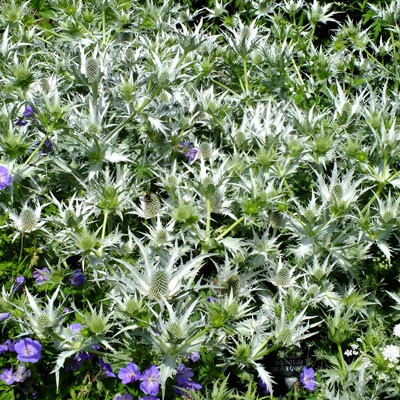
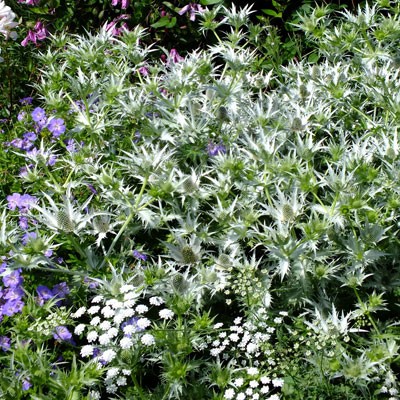

RHS AGM
Potsize - 1L
This new form of Miss Willmotts Ghost was discovered in the wild near Trabzon in Turkey in 1982 by Martyn Rix, Jimmy Smart and Dick and Ros Banks. It has flowers that are large with bracts that are narrower and more spiny than the species, in some ways a little more like a zabelii type. The leaves are also distinctive, being narrower with a wavier edge. It has the further advantage of a reputation for being more persistent and less reliably biennial than the species.Discount of 25p per plant for quantities of 3 or overLinks
Eryngiums Compared
Botanical Style Photographs
-

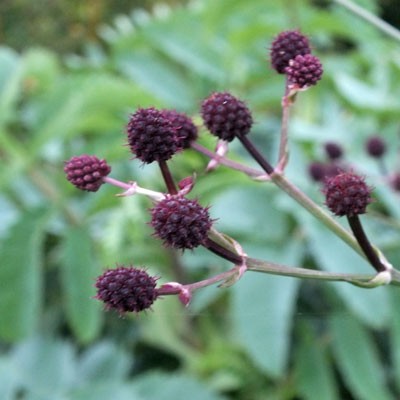
Potsize - 1L
(Eryngium descaisneum) If you are looking for a real talking point then this is the one for you. Eryngium pandanifolium 'Physic Purple' is bold, architectural and takes no prisoners. The foliage is a narrow 2cm wide and can be 1.5m long, evenly spiky all along its edge. It forms a dense grassy fountain, from the centre of which rises the star of the show. The flowering spike can rise 2.5m high or more, branched all the way up like a small tree to form a cylindrical cage of small deep maroon cones. Quite the show-stopper. The species grows naturally in South America, being found in marshes and wet fields. 2-4m. Hardy to -10C . Has a reputation for being less hardy but should be OK if grown in sun and not left to sit too wet in winter.Links
Eryngiums Compared
Botanical Style Photographs
-
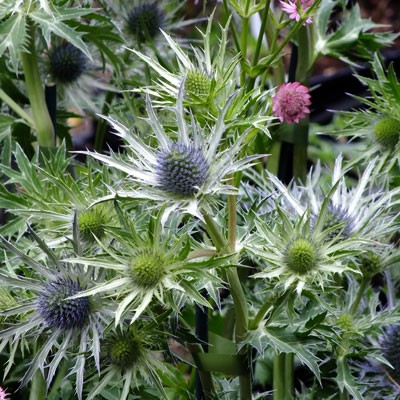


Bee Friendly
Potsize - 1L
A lovely cross between E.alpinum and E.bourgati. This form has particularly richly coloured bracts which are very long lasting. It is vigorous in growth and has large long-lasting heads of a bright metallic blue. Likes a position in full sun in not too rich a soil and not too wet. 75cmLinks
Eryngiums Compared
Botanical Style Photographs
-
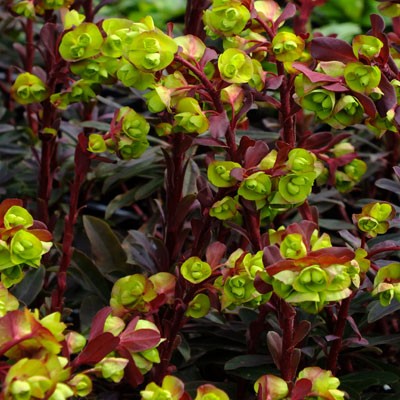
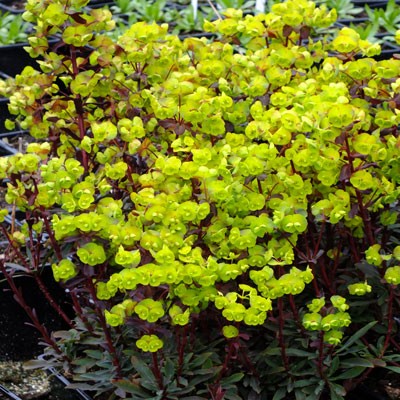
Potsize - 1L
Year round interest from rich deep maroon evergreen foliage with lighter burgundy new growth Topped in spring with bright yellow/green flws. HARMFUL IF EATEN. SKIN/EYE IRRITANTLinks
Euphorbia in the Garden
Botanical Style Photographs
-

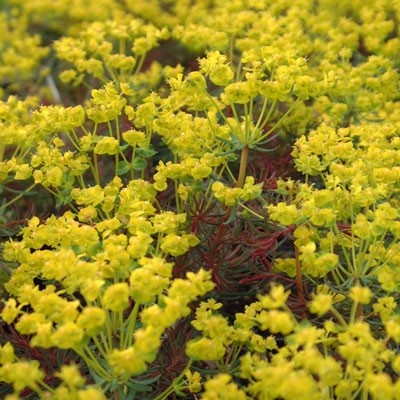
Potsize - 1L
Euphorbia cyparissias 'Red Devil'. Pretty little Euphorbia with deep red new growth which fades a deep sea green, the perfect foil for the bright acid yellow flowers produced in profusion in spring. It's only 20cm tall but a great assest anywhere. The fine thread-like foliage is lovely in its own respect, but the brightness of the flowers punch well above their weight and persist for so long, fading into rich autumn tones before they depart. Any soil. Will run. HARMFUL IF EATEN. SKIN/EYE IRRITANTDiscount of 25p per plant for quantities of 3 or overLinks
Euphorbia in the Garden
Botanical Style Photographs
-

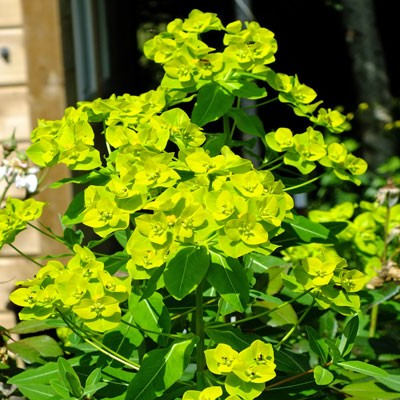
Potsize - 1L
(Schilling's Spurge). In many respects this lovely spurge is very similar to Euphorbia cornigera, However, there are some small but significant differences. Whereas E.cornigera stays very much put, Euphorbia schillingii has a more wandering rootstock - not enough to be a problem, just enough to make a more open bush. To go with this the flower heads are a little more open and appear about a month later in July to August. 1m. A Tony Schilling introduction from Central Nepal. HARMFUL IF EATEN. SKIN/EYE IRRITANTDiscount of 25p per plant for quantities of 3 or overLinks
Euphorbia in the Garden
Botanical Style Photographs
-

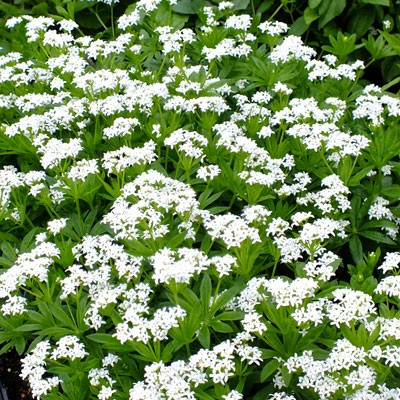
Potsize - 1L
Galium odoratum (Sweet Woodruff). (Rubiaceae) . Sweet Woodruff. A british native that really earns its place in a shady spot. It will quickly form an open carpet of bright green whorled foliage, enlivened in Spring with brightest white starry flowers. The leaves when crushed are said to smell of newly made hay. Its an undemanding plant that performs brilliantly in the sort of dry shaded situations that can be troublesome to fill. Honey produced by bees feeding on the nectar of this plant has been reported to have effects similar to Manuka Honey, but as to what evidence there is to back this up I cannot say.Discount of 25p per plant for quantities of 3 or over -
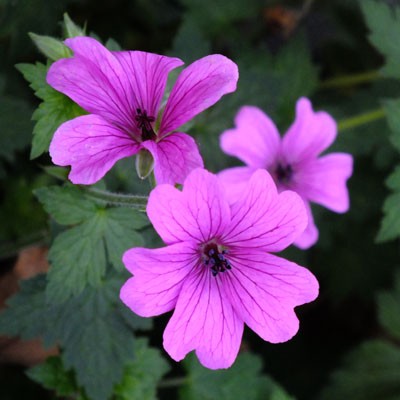

Potsize - 1L
Really vibrant 4cm wide flowers in a rich magenta pink with a deeper, almost purple venation and a gorgeous boss of blue-black stamens. The flowers are carried over really long season and look lovely with the black foliage of Ophiopogon which picks up the blackness of the eyes. The foliage in Spring is startlingly pale lemon with whiter edges and ages to a matt green with a hint of the darker spots typical of Geranium x oxonianum. Raised at Elworthy Cottage by Jenny Spiller in 2001 which is really all the recommendation you need. G.endressii ? crossed with G.wallichianum. Discount of 25p per plant for quantities of 3 or overLinks
Geranium Compared
Geranium in the Garden
Botanical Style Photographs
-
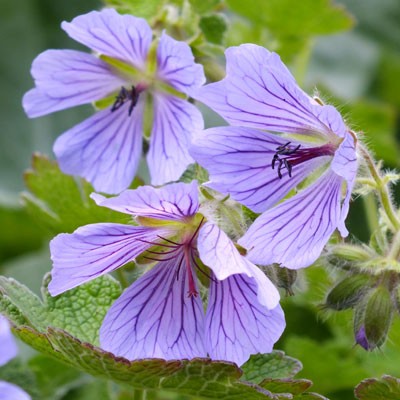
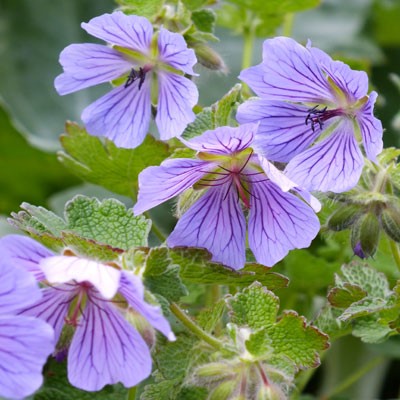
Potsize - 1L
Geranium ‘Philippe Vapelle’ (Geranium platypetalum x Geranium renardii) Felty grey-green leaves that have the texture of those of Geranium renardii form a neat evergreen mound. Nestled just above are flowers of a soft lilac-blue with prominent veining. The flowers are of a distinctive shape, the petals being wide spaced with blunt ended triangular outlined petals. Grows 40cm tall. June-July. A hybrid originally raised in Belgium by Ivan Louette. An identical plant was raised by Alan Bremner.Discount of 25p per plant for quantities of 3 or overLinks
Geranium Compared
Geranium in the Garden
Botanical Style Photographs
-

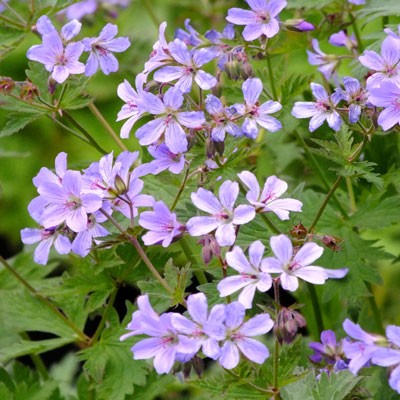
Potsize - 1L
(Geranium albiflorum x Geranium sylvaticum) I was drawn to this delicate geranium as it was so different from its cousins. It has small lustrous mauve flowers, 1cm wide with petals quite widely spaced. It has a lovely little curly puce pink style and flushes of magenta bee-lines. It really comes into its own when established and flowering en masse when the effect is quite charming. 45-90cm. An Alan Bremner cross. Discount of 25p per plant for quantities of 3 or overLinks
Geranium Compared
Geranium in the Garden
Botanical Style Photographs
-
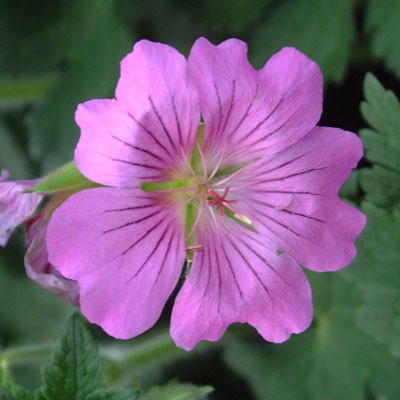
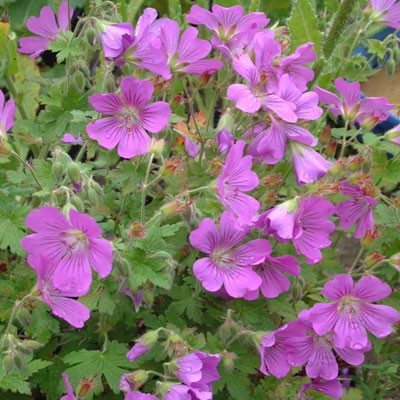
Potsize - 1L
Geranium ‘Sirak’ (Geranium gracile x Geranium ibericum). An outstanding new hybrid that produces masses of large flat bright pink flowers continuously for several months through the summer. Each flower is a shiny texture, coloured towards the bluer end of deep sugar pink with darker pink veining. The leaves are a pale green, resembling most the Geranium ibericum parent as does the plants general habit. A plant that will earn its keep in any planting scheme. 90cm. Bred originally by Hans Simon in Marktheidenfeld in 1992, an identical hybrid was also raised by Alan Bremner on Orkney.Discount of 25p per plant for quantities of 3 or overLinks
Geranium Compared
Geranium in the Garden
Botanical Style Photographs
-


Potsize - 1L
( G. libani x G. peloponnesiacum) An Alan Bremner hybrid. One of the first things to note about this hybrid is its mostly evergreen habit. Fresh leaves begin to grow well before Christmas so that there is a good clump of fresh shiny leaves present by the new year. The flowers come in April and are large soft floppy discs in lavender with nicely contrasting red calyces. Altogether a very nice variety that is not much seen. Discount of 25p per plant for quantities of 3 or overLinks
Geranium Compared
Geranium in the Garden
Botanical Style Photographs
-
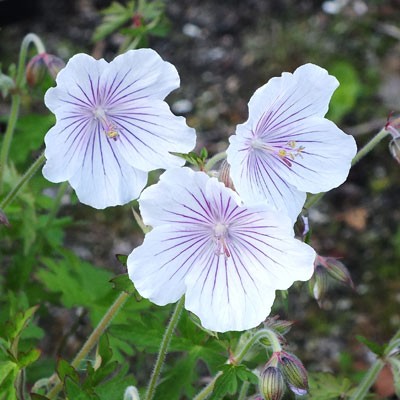
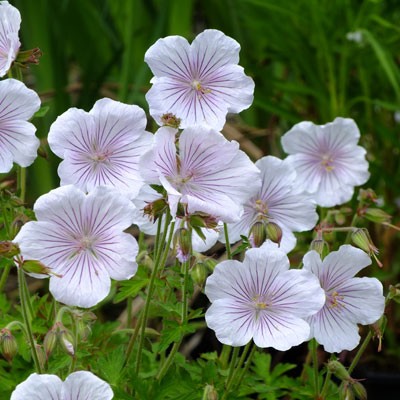
Potsize - 1L
Large, circular, pure white flowers (4.5cm, 2in). That is the petal overlap to give a bold effect with pleasantly undulating edges. The centres are pale, the anthers inconspicuous, but the many bee lines are picked out in deep papal purple creating the ghost of blush centre. The outer third remains pure white. A lovely thing, a bit like G.'Kashmir White' on steroids. Collected by Derrick Cook in 1984 in Narang province, Nepal. 30-45cm. Mature leaves are very large. Introduced by National collection holder Andrew Norton.Links
Geranium Compared
Geranium in the Garden
Botanical Style Photographs
-
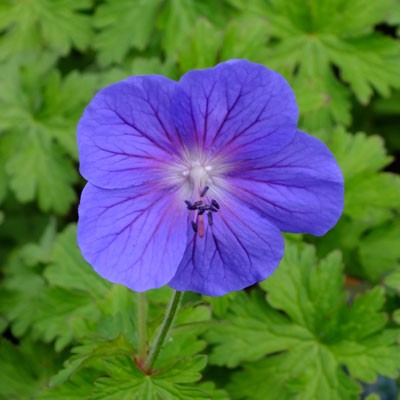
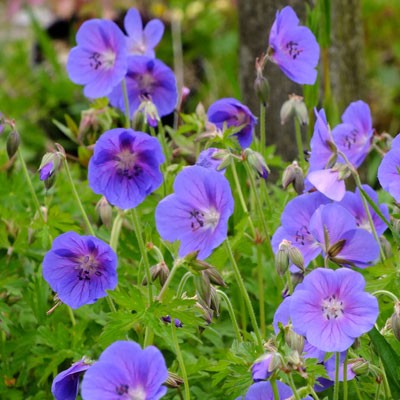
Potsize - 1L
Geranium himalayense 'Gravetye'. Large saucer-shaped blooms in a strong violet-blue are held well above the attractive foliage. 'Gravetye', selected from the garden of William Robinson, has flowers with a particularly pronounced central purplish flush on a more compact plant than the species. The species is a Himalayan plant that forms dense clumps of well cut foliage. Flowers April to July. Excellent red Autumn colour. Discount of 25p per plant for quantities of 3 or overLinks
Geranium Compared
Geranium in the Garden
Botanical Style Photographs
-
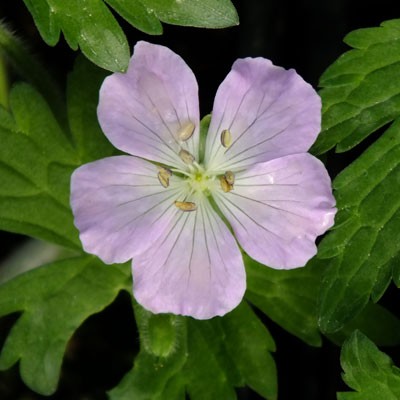
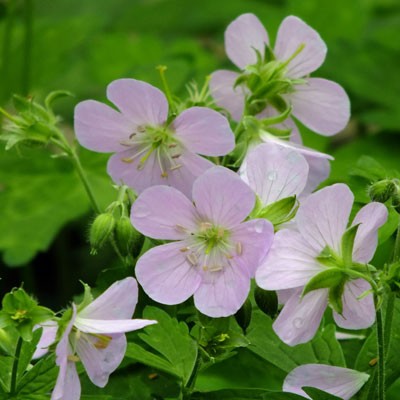
Potsize - 1L
Geranium maculatum 'Beth Chatto'. G.'Chatto' is distinguished by the most lovely clear, pale sugar pink flowers that it shows off to great effect in outward facing clusters above the pale green foliage. Larger and more deeply coloured than ‘Shameface’. Geranium maculatum is a variable moisture loving species; the best of the North American species. Flowers appear April to June (and often again in Autumn) with clusters of upward facing flowers well above the deeply cut leaves. Best in damp shadeDiscount of 25p per plant for quantities of 3 or overLinks
Geranium Compared
Geranium in the Garden
Botanical Style Photographs
-


Potsize - 1L
Geranium maculatum 'Espresso'. Impressive leaves which are deeply fingered and coloured brown, a colour which lasts well into the Summer. Flowers are produced early and are pale pink. The whole plant is a little smaller than ‘Elizabeth Ann’. Geranium maculatum is a variable moisture loving species; the best of the North American species. Flowers appear April to June (and often again in Autumn) with clusters of upward facing flowers well above the deeply cut leaves. Best in damp shade, but needs some sun to develop the leaf colour . Raised by Dale Hendricks of North Creek Nurseries, USA. Discount of 25p per plant for quantities of 3 or overLinks
Geranium Compared
Geranium in the Garden
Botanical Style Photographs
-
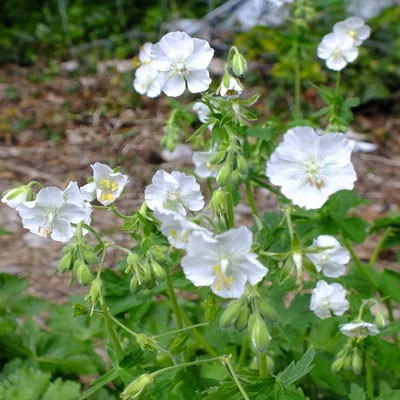
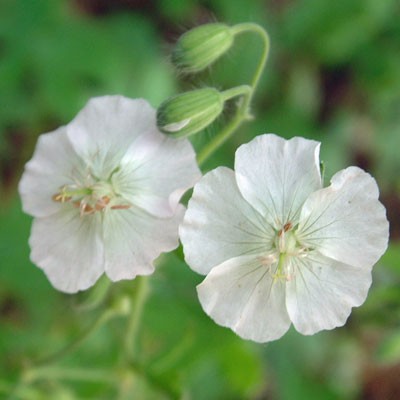
Potsize - 1L
Geranium phaeum 'Album'. The pure white form of the Mourning Widow. Good clean white flowers which are relatively large for the type and lack any central ring. More or less evergreen mounds of foliage and upright stems topped with outward facing flowers. Good in dry Shade. Originally collected in the wild in Switzerland by Dr Roger-Smith and Miss Savory, part ofan AGS party in 1940. Discount of 25p per plant for quantities of 3 or overLinks
Geranium Compared
Geranium in the Garden
Botanical Style Photographs
-


Potsize - 1L
Raised by Jim Haunch, nurseryman and holder of the National Collection of Geranium phaeum and given to us by Jennifer Harmer as 'a very good do-er'. This is a cross between G.phaeum 'Samobor' to which it is like a large version, and G.phaeum 'Golden Spring'. It has plum purple flowers above leaves that are well marked throughout the season with maroon blotches, but show a paler centre in the early season. It was described by the raiser as "..a good mound former with leaves of a creamy yellow to almost white in the centre, red streaks and brown blotches on each side of the central vein of the leaf blades and a green with very pale almost white splash marks near the leaf tips. The flowers are a plum-purple, contrasting well with the leaves.".Links
Geranium Compared
Geranium in the Garden
Botanical Style Photographs
-


Pot size - 1L
A really unusual uniquely double flowered phaeum. A showy double row of bright plummy purple petals and in the centre the stamens appear to have been transformed into strange petaloid structures ina alimey-green to fascinating effect. A plant for partial shade wherethe slightly blotched fresh green leaves make an early foil for other spring flowers. Flowering in late April to May to about 75cm. This wonderful find was a chance seedling in the garden of Lynne Edwards in 2013. She named it after her beloved father and lifelong botanical & gardening mentor who had ghiven here her original phaeum. Not so good for insects due to its lack of stamens. fusion_separator style_type="single solid" hide_on_mobile="small-visibility,medium-visibility,large-visibility" class="" id="" sep_color="" top_margin="" bottom_margin="" border_size="" icon="" icon_circle="" icon_circle_color="" width="" alignment="center"][/fusion_separator]Links
Geranium Compared
Geranium in the Garden
Botanical Style Photographs
-
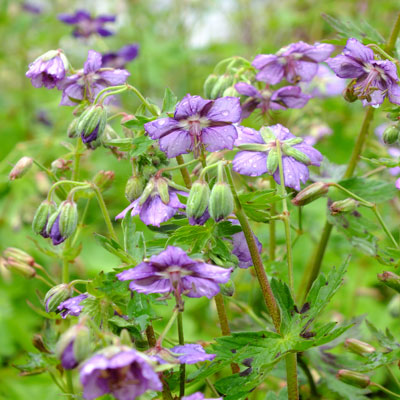
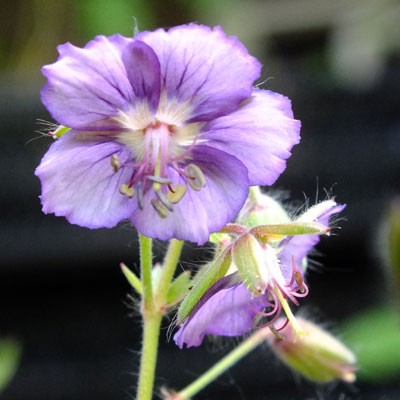
Potsize - 1L
This is one of those plants whose flowers warrant the closest of inspection as they posses the sort of intricate beauty that can easily get overlooked amongst some of their more brash cousins but which nevertheless is as exquisite as they come. Each flower is a translucent lavender-white shaded to the edges and picked out lavender in the veins. Where the petals overlap the colour is stronger and from the white eye protrude a green style and pink anthers. Typical green G.phaeum foliage with small but distinct chocolate spots. Bred by an unknown Dutch gardener. Discount of 25p per plant for quantities of 3 or overLinks
Geranium Compared
Geranium in the Garden
Botanical Style Photographs
-
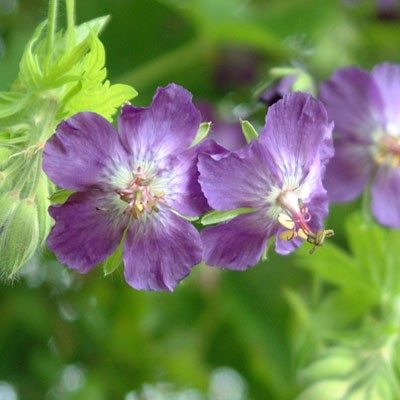
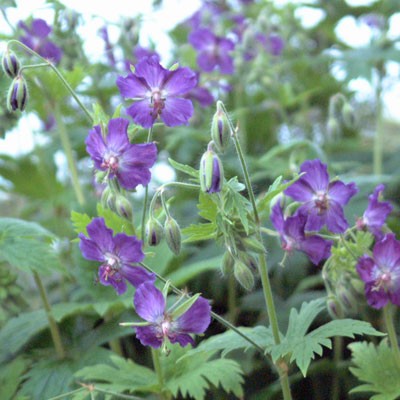
Potsize - 1L
Geranium phaeum 'Lily Lovell'. A striking form of this cranesbill raised at Mayford, Surrey by the Geranium expert Trevor Bath and named in memory of his mother. It is distinguished by it's larger flowers of a rich dark purple with pale centres and its distinctly pale foliage. Overall the plant is large and open in appearance for a G. phaeum type. Plants form dense clumps of pale foliage which succeed even in deep, dry shade. 80cm. Discount of 25p per plant for quantities of 3 or overLinks
Geranium Compared
Geranium in the Garden
Botanical Style Photographs
-
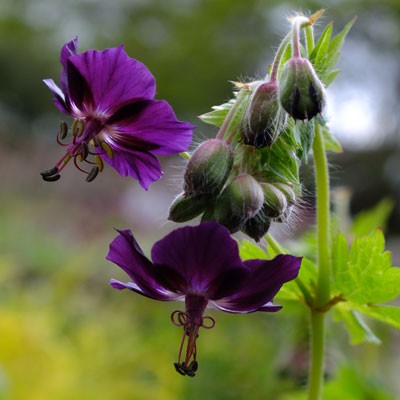
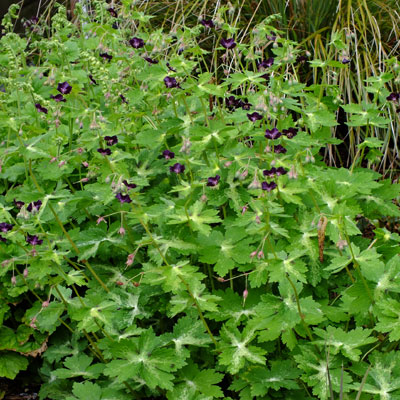
Potsize - 1L
Handsome foliage especially in Spring and Autumn when the hearts of the leaves are cool cream, gradually mottling out towards the edge. The deeply incised leaves are further decorated by strong black spots at the deepest points of the lobes. 50cm. Flowers are silvery purple, highly reflexed, with pink tipped anthers. They are produced over a long period from April to July. Easy and rewarding. Introduced by Coen Jansen. Discount of 25p per plant for quantities of 3 or overLinks
Geranium Compared
Geranium in the Garden
Botanical Style Photographs
-


Potsize - 1L
A new colour break within Geranium phaeum with unusual creamy coloured buds and newly opened petals which develop into multi-tonal lilac-pink rayed flowers. The effect s enhanced by the maroon flush on the pedicels and calyx. The leaves are boldly marked with a maroon star. Good for sun or shade and excellent for early pollinators. Flowering May-June. 80cm. If all this wasn't persuasive enough, this variety was raised by Beth Chatto. Discount of 25p per plant for quantities of 3 or overLinks
Geranium Compared
Geranium in the Garden
Botanical Style Photographs
-
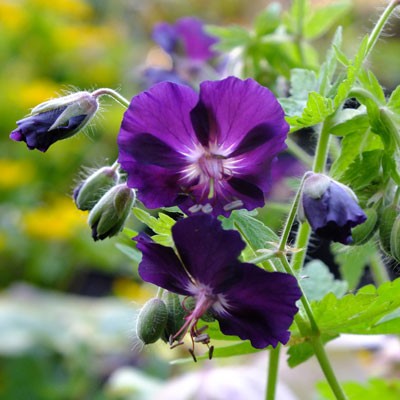
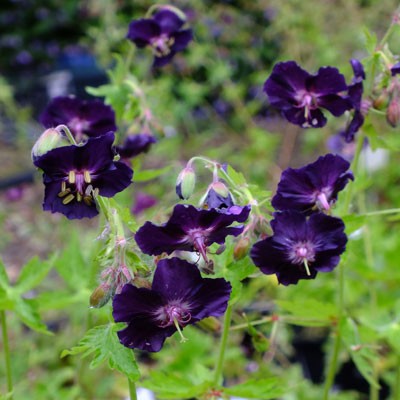
Potsize - 1L
Geranium phaeum 'Raven'. MOURNING WIDOW. A useful ground cover plant with striking dark purple flowers held high above dense clumps of pale foliage. Raven has unspotted leaves and purple-brown flowers and is relatively short growing at just 40cm. A seedling from 'Lily Lovell' introduced by Rainforest Nursery, Canada. Discount of 25p per plant for quantities of 3 or overLinks
Geranium Compared
Geranium in the Garden
Botanical Style Photographs
-


Pot size - 1L
Soft mauvy-blue flowers with a grey ring make this an unusual, rarely offered colour break for a G.phaeum. Good leafy clumps of unblotched fresh green leaves make excellent Spring foils to other plants in partial shade. Flowering in late April and May these pretty phaeums provide a valuable nectar source fro early insects. 60-75cm fusion_separator style_type="single solid" hide_on_mobile="small-visibility,medium-visibility,large-visibility" class="" id="" sep_color="" top_margin="" bottom_margin="" border_size="" icon="" icon_circle="" icon_circle_color="" width="" alignment="center"][/fusion_separator]Links
Geranium Compared
Geranium in the Garden
Botanical Style Photographs
-
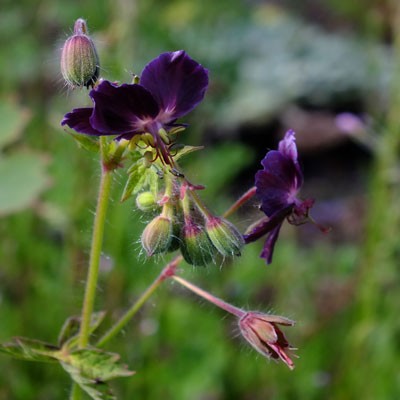

Potsize - 1L
Golden Spring foliage becomes suffused with green and is marbled with a maroon, roughly heart-shaped ring at the depths of the lobes. The flowers are the deepest, richest royal purple. Like all the phaeums it positively thrives in dry shade, though the yellow tones of the leaves may be less strident. A chance seedling found by Piet Oudolf. Discount of 25p per plant for quantities of 3 or overLinks
Geranium Compared
Geranium in the Garden
Botanical Style Photographs
-
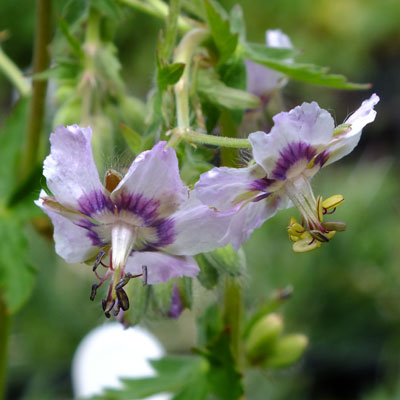
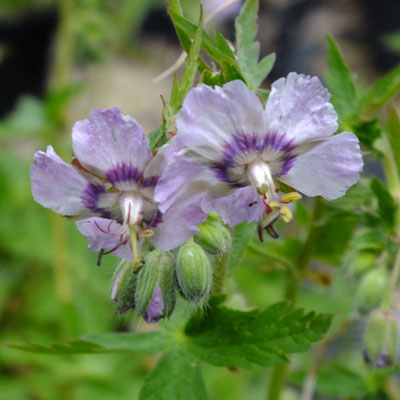
Pot size - 1L
A distinctively marked G.phaeum with pretty almost white petals surrounding a central violet ring. Flowers take on a slight pink blush as they age. Good, vigorous clumps of bright green foliage send up leafy stems topped with small but showy flowers from late April. 45cm. Phaeums enjoy a semi-shaded position and provide a valuable source of pollen and nectar for early insects. Raised by Andre Ekkleboom in Holland and named for his wife. fusion_separator style_type="single solid" hide_on_mobile="small-visibility,medium-visibility,large-visibility" class="" id="" sep_color="" top_margin="" bottom_margin="" border_size="" icon="" icon_circle="" icon_circle_color="" width="" alignment="center"][/fusion_separator]Links
Geranium Compared
Geranium in the Garden
Botanical Style Photographs
-

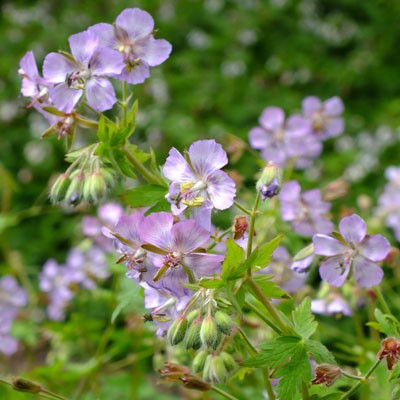
Potsize - 1L
Geranium phaeum var. lividum 'Joan Baker'. The original large flowered form of Geranium phaeum var. lividum was collected on an Alpine Garden Society tour of the dolomites by Bill Baker. Subsequently it was propagated by Axletree Nursery and an attractive pale lilac seedling was selected and named after Bill's wife Joan. Geranium phaeum var. lividum 'Joan Baker' is a robust geranium and grows strongly to 90cm, even in quite dry shade, making a very useful plant indeed.Discount of 25p per plant for quantities of 3 or overLinks
Geranium Compared
Geranium in the Garden
Botanical Style Photographs
-
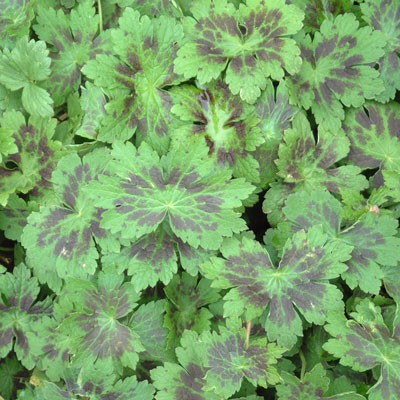

Potsize - 1L
Geranium phaeum var. phaeum 'Samobor'. MOURNING WIDOW. Particularly striking leaf markings distinguish this useful ground covering geranium. Each leaf is relatively large for the type and zoned with chocolate brown, rather in the way of a pelargonium. Dark reddy-maroon flowers add to the effect and are brilliant with the light coming through them. Overall the plants have a compact, tight appearance. Succeeds even in deep, dry shade. 80cm. Introduced by Elizabeth Strangman of Washfield Nursery from a collection near Samobor, Croatia, in 1990. Discount of 25p per plant for quantities of 3 or overLinks
Geranium Compared
Geranium in the Garden
Botanical Style Photographs
-
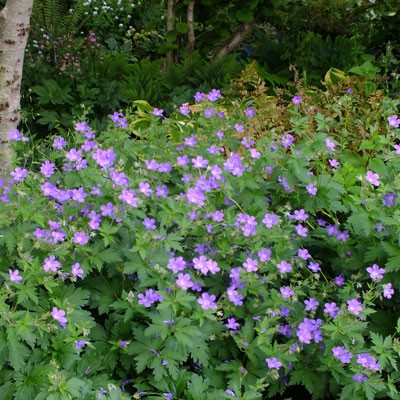
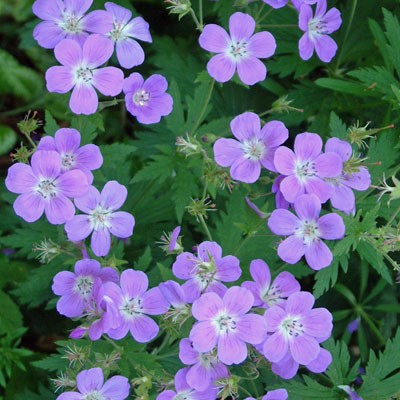
Potsize - 1L
Geranium sylvaticum 'Mayflower' - (wood cranesbill). Glossy medium green leaves form a good clump to 1ft tall, well above which are held in May the branched heads of white centered rich violet- blue flowers. Bluer than Geranium sylvaticum 'Birch’s Lilac’. The crown is a knobbly mat of rhizomes which sprout in spring stiff upright stems of fresh pale green leaves. May-June. Best in partial shade where it is very useful. May-June. Raised in the early 1970's by Alan Bloom.Discount of 25p per plant for quantities of 3 or overLinks
Geranium Compared
Geranium in the Garden
Botanical Style Photographs
-
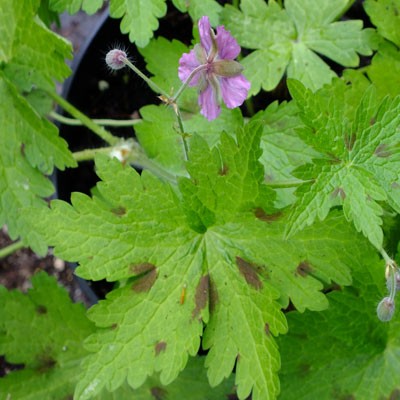
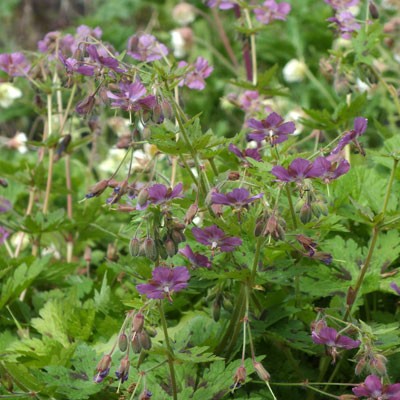
Potsize - 1L
A dusky pink spring flowering Geranium. Typical of its parents, G.phaeum and G.reflexum, it has sprays of long-nosed, slightly reflexed petaled flowers with a white eye and a ring of smoky blue eye-liner. Generous clumps of large palmate and lobed leaves are handsomely marked with strong maroon blotches and stand well in shade, even if dry. Even better is the lovely golden hue the leaves take on in early Spring before greening up later. Really brightens up a shady corner. Originated in the French nursery of its namesake. 45cm tall, spreading indefinitely. Selected by Madame Claudine Dupont. Discount of 25p per plant for quantities of 3 or overLinks
Geranium Compared
Geranium in the Garden
Botanical Style Photographs
-


Potsize - 1L
A fitting name for this lovely Geum. It has 5 rows of frilly petticoat-like petals in a warm soft yellow, all suffused with peach. The centre of each flower has a big boss of yellow stamens tipped with brown anthers all ringed around with the red styles in the middle. Flip the flower over and you find it is washed over in a lovely apricot shade with a dark red calyx and stem. All in all its enough to get you grabbing your skirt and bursting into song. Discount of 25p per plant for quantities of 3 or overLinks
Geum Varieties Compared
Botanical Style Photographs
-
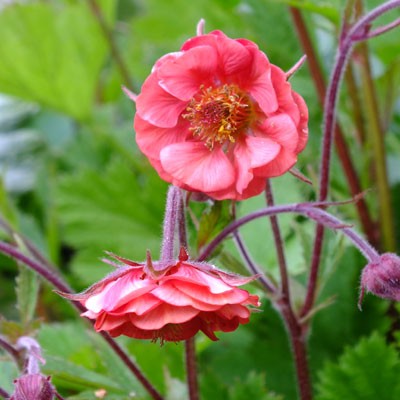

Potsize - 1L
I think this is a slow burner rather than a red hot Latin lover, but it's certainly a Geum to fall in love with. Geum 'Flames of Passion' is relatively short and neat at a foot high. The flowers are 2cm across and look down in a rather coy fashion. They are strawberry pink, slightly ruffled with 3 rows of petals and a charming yellow centre with a green eye. The dark maroon buds and stems round off the effect nicely. So if you are feeling coy yourself, perhaps it's time to give passion a try. Discount of 25p per plant for quantities of 3 or overLinks
Geum Varieties Compared
Botanical Style Photographs
-
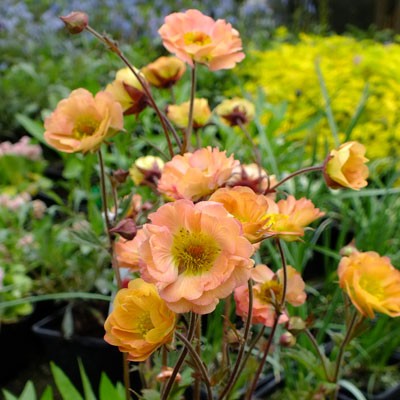

Potsize - 1L
Geum 'Mai Tai'. One of the denser clumping geums of mid size. The flowers are large, frilly and a beautiful red stained peach. Keep cutting out old flowering stems to encourage a succession of flowers. Discount of 25p per plant for quantities of 3 or overLinks
Geum Varieties Compared
Botanical Style Photographs
-

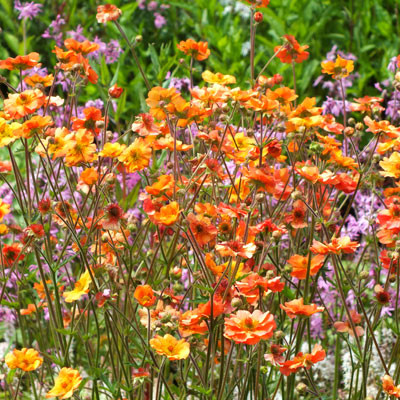
Potsize - 1L
Introduced by Hardy's in 2010, this Geum has built up a great reputation for reliability and impact. It is a sterile hybrid that will hold its zingy semi double orange flowers on stems up to 90cm tall and keep on producing them over an extended season. The flowers can vary in shade from a rich orange back towards a more mellow shade. From a distance it reminds us somewhat of Geum 'Hilltop Beacon' but the growth habit is much more upright and tighter packed. Discount of 25p per plant for quantities of 3 or overLinks
Geum Varieties Compared
Botanical Style Photographs
-
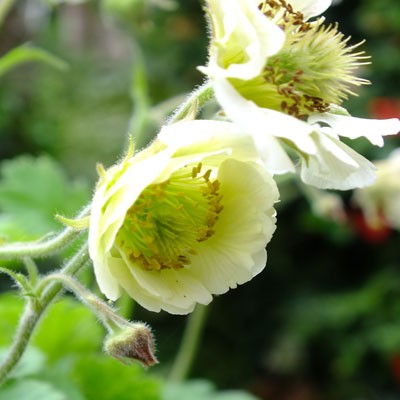
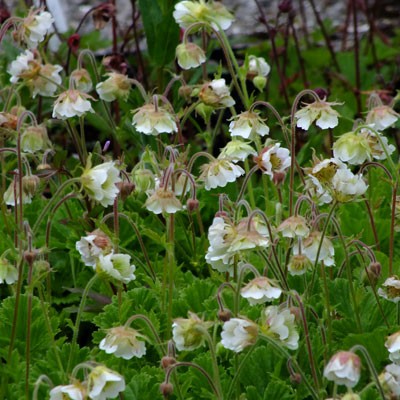
Potsize - 1L
This is one for those of you that like something a bit more subtle - a bit of a symphony in cream and green. There are up to 3 rows of petals, each one long stalked giving a gap at the flower base. They are white, deliciously green shaded in the bee lines and the throat, especially as they first open. The flowers hang down so you need to get down to appreciate the fluffy green styles. It is a good clumper and short at 12 inches Discount of 25p per plant for quantities of 3 or overLinks
Geum Varieties Compared
Botanical Style Photographs

















































